#somewhat historical garment
Explore tagged Tumblr posts
Text
A proper roman toga is surprisingly high on my „Historical garments I want“-list. Which I of course have. I mean it‘s basically just a giant blanket you wear! And look great in when lounging around! And don‘t need to wear pants with!
#historical fashion#ancient rome#anyone interested in the somewhat complete list of historical garments I want?
0 notes
Text




Countries featured: Poland, Estonia, Slovakia and Ukraine.
really enjoyed dressing them up last time, have some more. ramblings below.
none of this is historically accurate, and my research is limited by only the free materials that can be found online TT i'm very sorry for the inaccuracies TT
as always, men's clothes are soooo boring compared to women's. i tried picking the most embroidered ones for fun, but half of men's clothes in eastern/central europe are like "coat-type garment in brown/black/white with minimal decoration". also tried to draw kim the coolest jackets/coats i could find, sksdfdfkd.
probably, both of them are too old to be wearing something as flashy. if we look at them through the 19th century lense, societal norms expected them to be married and settled already, with that come more muted garments with less decorations.
though, it's probably somewhat in character for harry to be wearing something extravagant from when he was young, unable to let go of those days. and kim isn't exactly subtle with his historical cosplay jacket either. both of them are freaks.
estonian clothes are so well-organized and documented. i really liked the knitted mittens, socks and sashes, very beautiful!
slovak clothes are so cool! i'm too much of a coward for the detva crop tops, but harry would wear something like that 100%. also they have aprons for men. delightful.
and ukrainian clothes, the ones i know the most about.
women were expected to make clothes for their husbands. in general, embroidery was a very personalized thing, people would sometimes sew their initials and names somewhere on the garment.
so, imagine harry having clothes dora hand-made. with unique patterns that could be referencing, let's say, apricot flowers. that would be so fucked up!!
the actual plants commonly featured in embroidery patterns are roses, oak leaves, hops, grapes, viburnum, poppies and marigolds.
language barrier is, unfortunately, very real. my polish is mid enough for reading and i can understand slovak using the ✨slavic languages magic✨, but estonian? google translate did not want to cooperate. it kept translating something as "pussy belt" TT
in any case, feel free to send anything about folk clothing, i'll be very happy and thank you for reading!
895 notes
·
View notes
Text
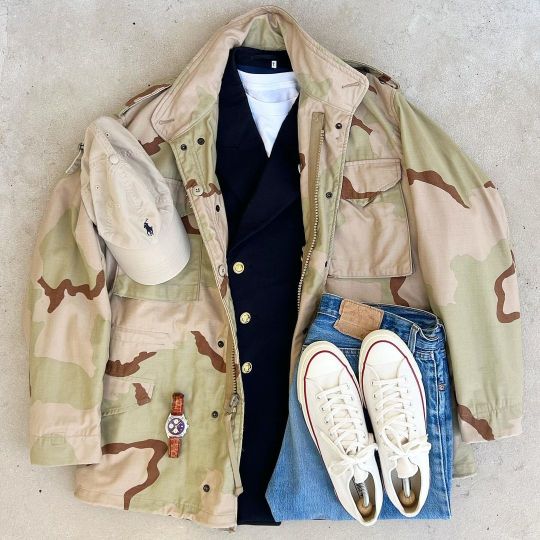
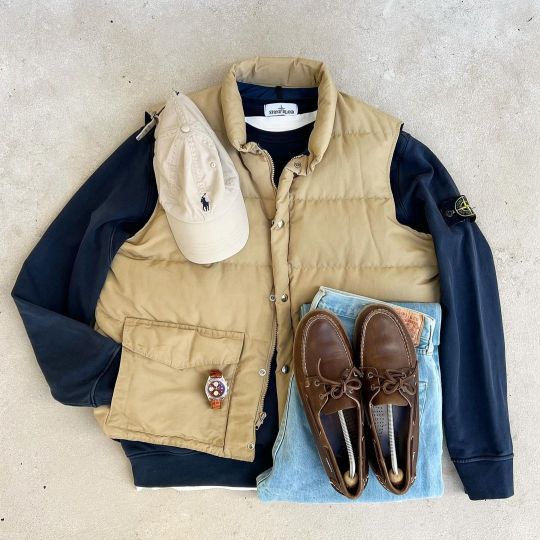
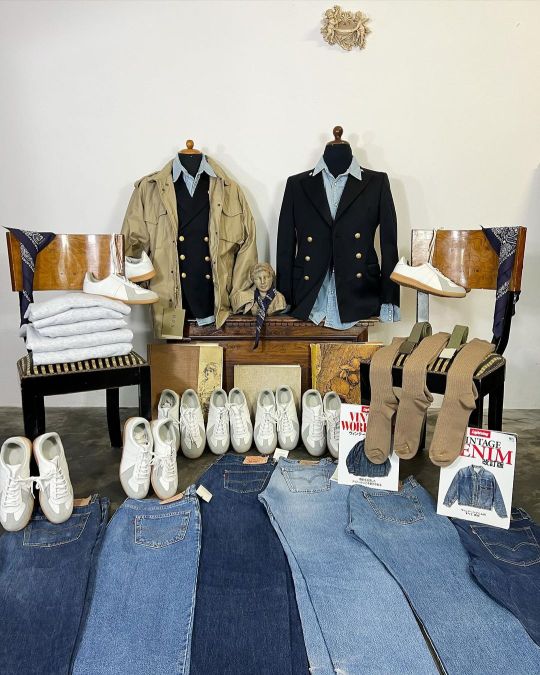

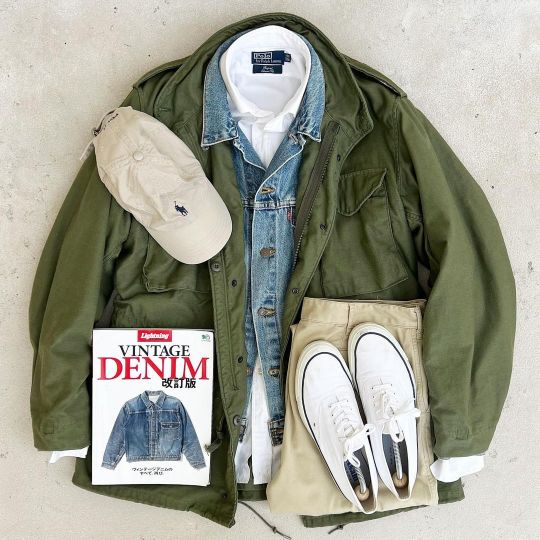
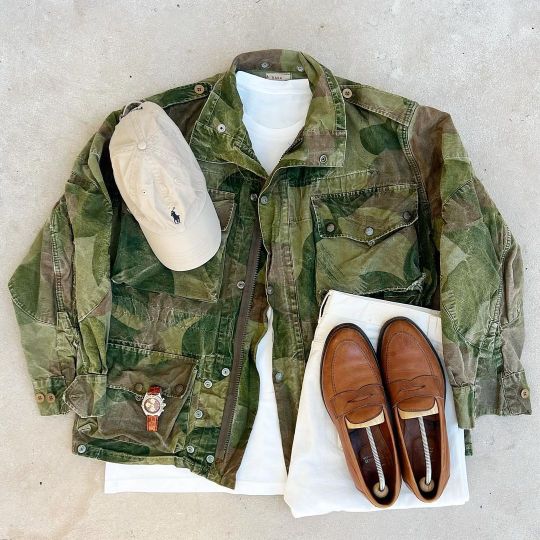
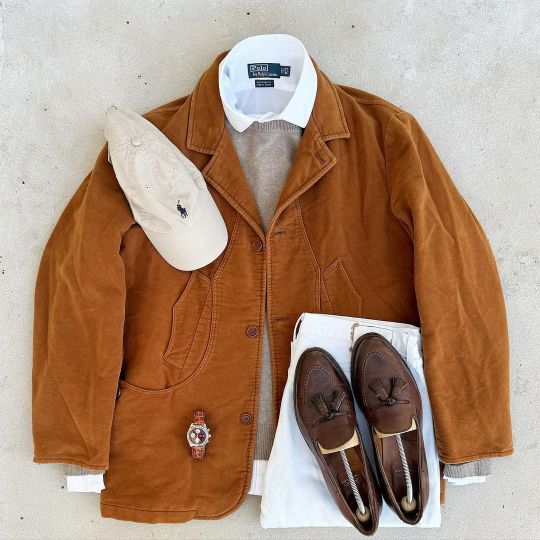
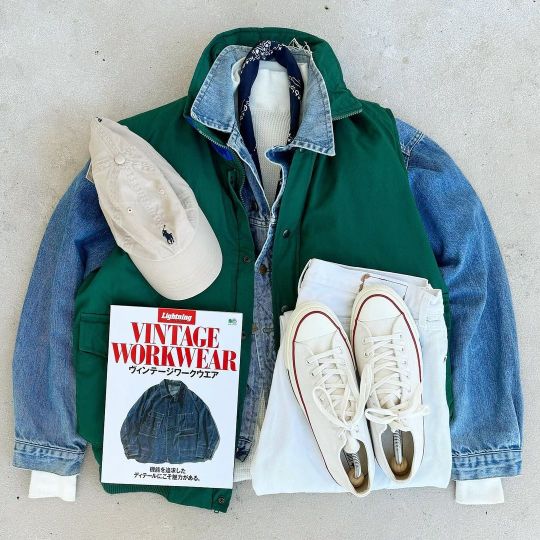
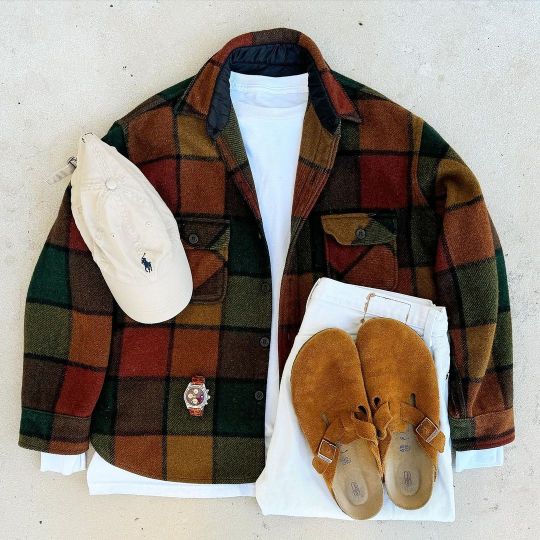
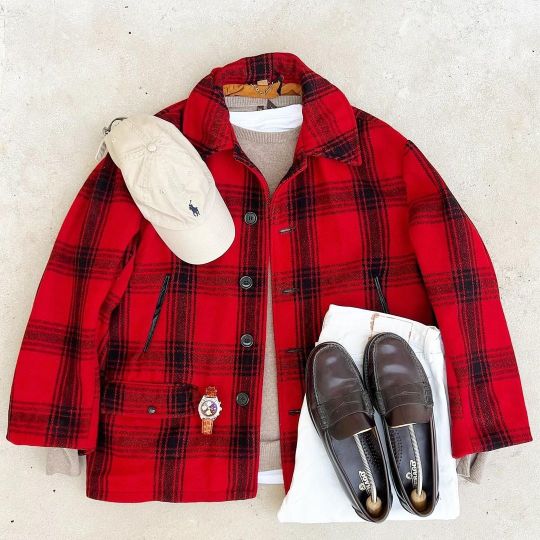
Introducing: Mr. Archive
What better way to kickstart 2024 than with one the most beautifully curated, styled and fair-priced vintage stores out there?
Mr. Archive has been one of my go-to places the last few months, be it for visual inspiration on their instagram profile or the browse some of the most interesting pieces around. To be fair, after 15 years of working in this industry is getting more and more difficult for me to find garments and brands that are truly exciting and fresh. If on top of that we take into account the price point of some of these labels, many of which produce in Portugal with accessible costs, my enthusiasm dims even further.
I’ve always been passionate about the universe of vintage and pre worn garments, but this love has been fueled in recent years by the appearance of highly specialized shops that seem to be perfectly in tune with my personal style. I’ve had the chance to chat with Matteo, the mastermind behind Mr. Archive to learn more about this outstanding project.
BF: I came across Mr. Archive fairly recently and I must say that it definitely hit a soft spot within the range of vintage providers currently on my radar. How long have you been in business? What drove you to create it?
Matteo: I'm passionate about my job, believe I have a somewhat general knowledge of the fashion world, but about 4 years ago, I got fascinated by this industry, even though I already knew it. I come from a family that has always worked in the clothing industry.
BF: For me, your selection is perfectly curated, bringing a mix of military and navy-inspired garments, with a twist of Americana. Is this an extension of your own style and taste, or is it more business-oriented?
Matteo: What I propose is all based on my personal taste; I create outfits on the spot, drawing inspiration from magazines, newspapers, etc., and then I elaborate and create. My mom is an artist, and I think I took inspiration from her.
BF: Vintage has always inspired me ever since I got into fashion roughly 15 years ago. There's just something distinctive about the fabrics and the history behind each garment that you can not replicate with new items. How/where do you source your amazing selection?
Matteo: My pieces come from warehouses worldwide; I'm constantly looking for new things, and that's the wonderful thing about my job! I have strong trust in my suppliers!
BF: With sustainability being the word of order when it comes to fashion, have you noticed an increase in demand for pre-owned garments? Do you think part of the solution can be provided by vintage?
Matteo: Recently, there has been an increase in the purchase of vintage and second-hand clothing items. To be honest, I believe that a few years ago, not many people knew about this world, but now it's expanding and captivating even those who knew little about it.
BF: I noticed you have a small capsule of garments carrying your own label, namely selvedge denim and accessories. What's the story behind those? Can we expect more designs in the future?
Matteo: I won't deny that creating my own clothing line would be a great personal satisfaction, a significant growth. I recently created a small line, "MRARCHIVE," currently composed of jackets, pants, and hats. One day, I'd like to expand, but I still have much to learn and study.
BF: Any tips or advice you wish to leave for those more reluctant to explore the world of previously owned items? It's still somewhat taboo for some people.
For many people, this world is still a taboo; they're still stuck in the thought of "they're used clothes." What I think is that one should see the story and originality behind each piece to appreciate its value, both from a historical and an aesthetic perspective. Sometimes, I compare some clothing items to paintings—they should be framed.
You can find Mr. Archive here.
#Mr. Archive#menswear#men's fashion#vintage#pre-owned#style#fashion#inspiration#beyond fabric#men's style#collection#lookbook#store#shop responsibility#military#navy
280 notes
·
View notes
Note
I apologize if this is a stupid question, but the Amazon corset discourse has me wondering: some of these young women are complaining that their corsets are causing rib pain. I've had the same problem from sports bras worn for too long and have heard of something similar with binders. I am interested in trying out wearing a corset as a support garment (I have a large chest and like the idea of spreading out the weight), but is there a way to avoid that risk when I am testing the fit?
I’m guessing it has something to do with not being a good fit?
I honestly don’t know because I really only know people who’ve worn historical corsets, not the Amazon kind, and none of them have had that complaint. I have no doubt that you still can with any style of garments that has any amount of compression around your ribs, if it’s not fitted well, but… I guess I just mostly know people who’ve been scrupulous about the fit of their corsets. It could also be an effect of boning versus heavy duty elastic, if the Amazon corsets primarily use the latter? But I don’t actually know enough about them to say
Which I suppose is an answer in itself: just make sure you get something decent quality that fits well. Take your measurements before ordering, go to a reputable corsetier (I really like RedThreaded, but they are somewhat expensive; I’ve heard that Orchard Corset is also good. AVOID CORSET STORY/CORSETS UK.), etc.
Best of luck!
43 notes
·
View notes
Text
Making the ✨Lioncourt Gown✨ (Part 3/4)
It has been a little longer than I had hoped for since my last update but I've made some progress! The tape has finally arrived.
But for context - I am trying to make this:

into a (semi) historically accurate 1790s women's redingote and it's probably my favorite project so far. Anyways, here's what I did since my last update.
The tape arrived, but it was a little too light (it was basically white, I'd wanted it to be sort of beige/champagne) so I decided to dunk it into some coffee and hope for the best. It did work somewhat, stained it a pretty champagne color. It's still on the lighter side, but I'm okay with it. It may look white in some pictures though. Unfortunately, I completely forgot to take pictures of my dyeing process. Just imagine a tupperware full of instant coffee and some white tape in it haha. It's also thicker than I would have liked it to be but it was the thinnest one available, and I'm pretty glad it's thick-ish because with how difficult it is to sew it, I don't want to imagine my struggle with an even thinner tape.
I'd already prepped the color panels, so I applied the tape and used my sewing machine to sew them really close to the edges. A very time-consuming but weirdly therapeutic process. I started with the bodice and then went on to do the sleeves.
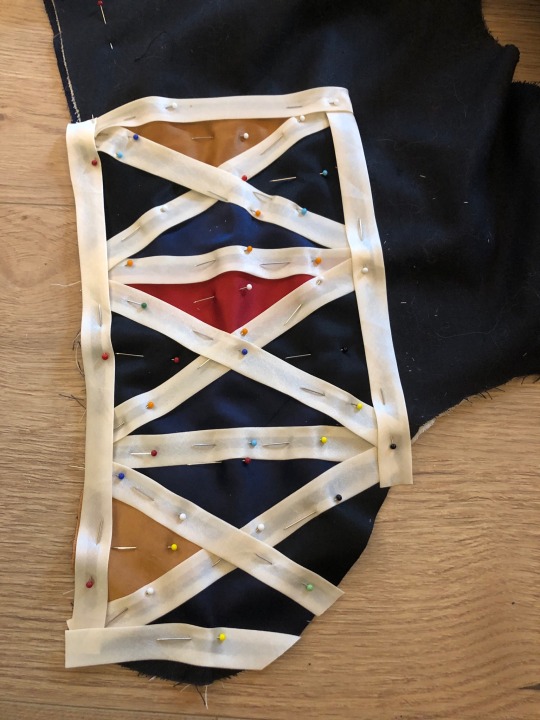



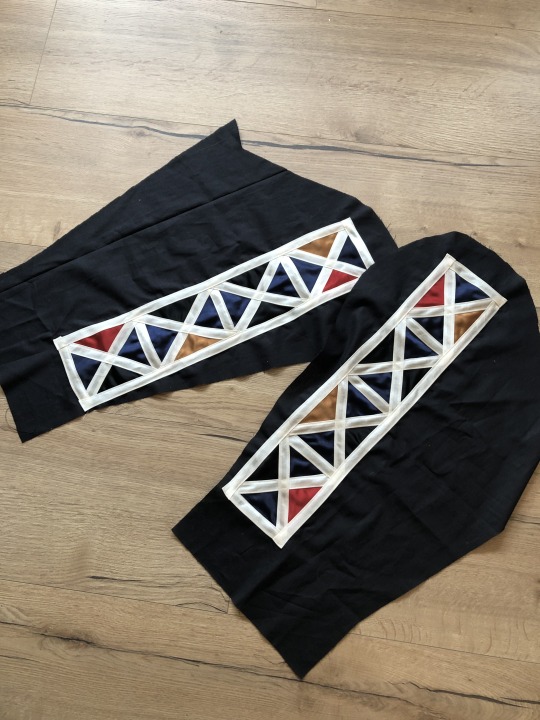
The sleeves seem to have black cuffs in the original picture, so I added some of that satin fabric to the sleeves.
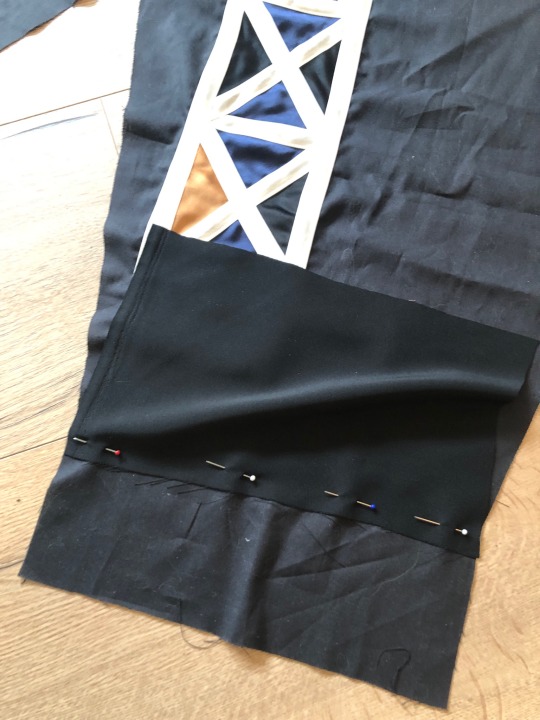


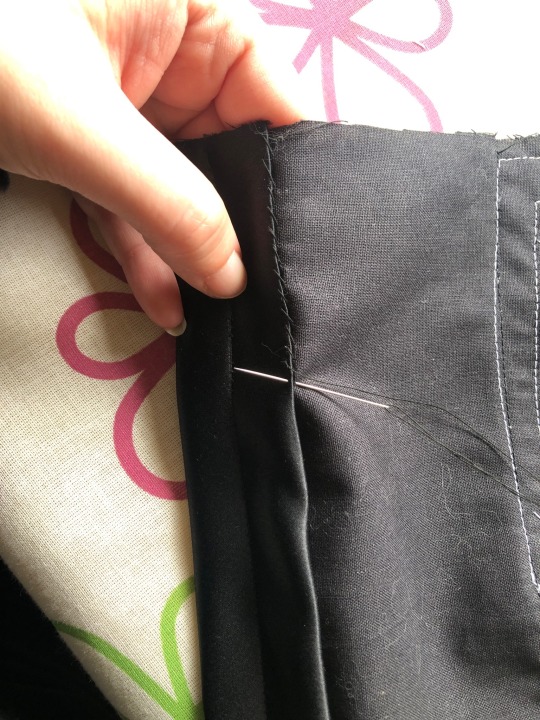
Next, I attached the sleeves to the bodice. I can't help myself, I have to say it again: I hate sleeves. I hate sewing them, I especially hate attaching them, because they never turn out the way I want them to. This time again, I had to add little pleats to the tops because the armscye was too small for the sleeves, but since it's going to be covered by the collar anyways, I just pleated them. Redingote sleeves may have been pleated sometimes, it's hard to tell from the pictures of extant garments because of the huge collar, but it was a trend a bit earlier so it may have carried over to the redingotes.
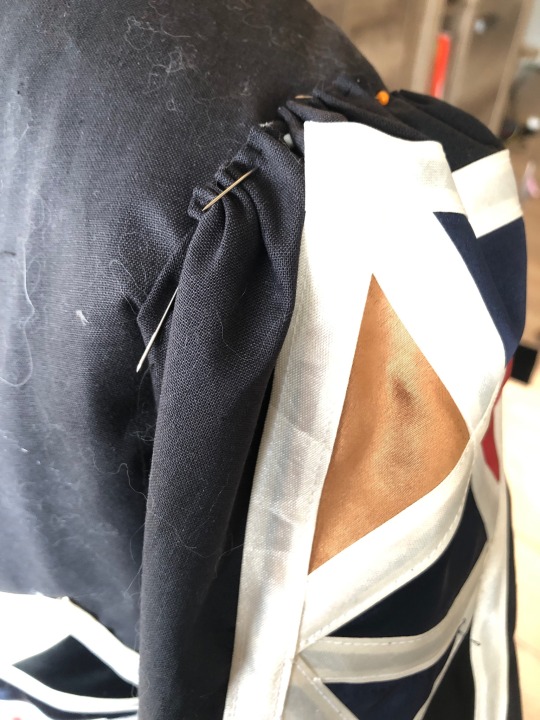
I'm sorry about the cat fur in this picture I lost my lint roller I promise I'll find it.
When I was done with the sleeves, I attached the Lioncourt label to the inside of the bodice-
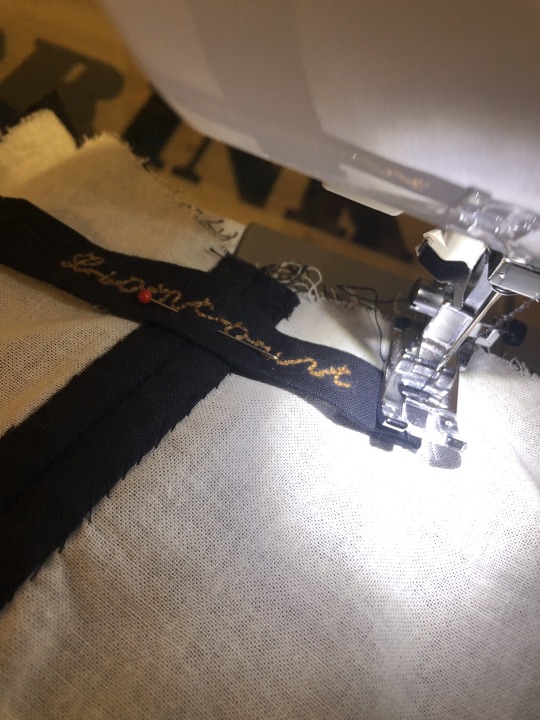
and went to work on the collar. I've put off making it as long as possible because I didn't really know how to attach it to the bodice, but I think I've figured out a way. I'd made the back neckline without any seam allowance, so I found an old scrap piece of black cotton bias tape and used that to hem the raw edge.

Then I draped some of my mockup fabric to figure out the correct shape of the collar and after some trial and error (cutting it out a total of three? or four times), I was finally happy with the shape and cut it out of the navy cotton twill.

I cut out two pieces of each so it would be sturdier, machine-stitched along the neckline part, turned it inside out, pressed it with an iron and applied the red tape. I seem to have forgotten to take a picture of the tape application process, but I then also applied the red tape to the entire bodice.
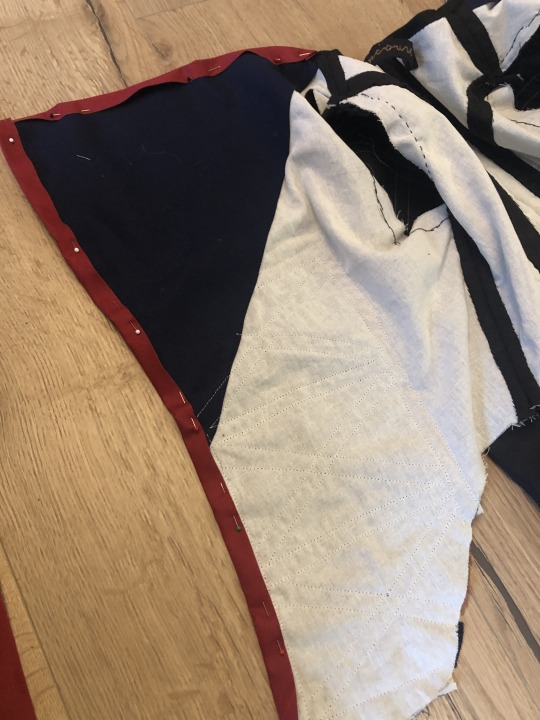
And here's the entire bodice so far (the collar is not attached yet so it looks a bit wonky):
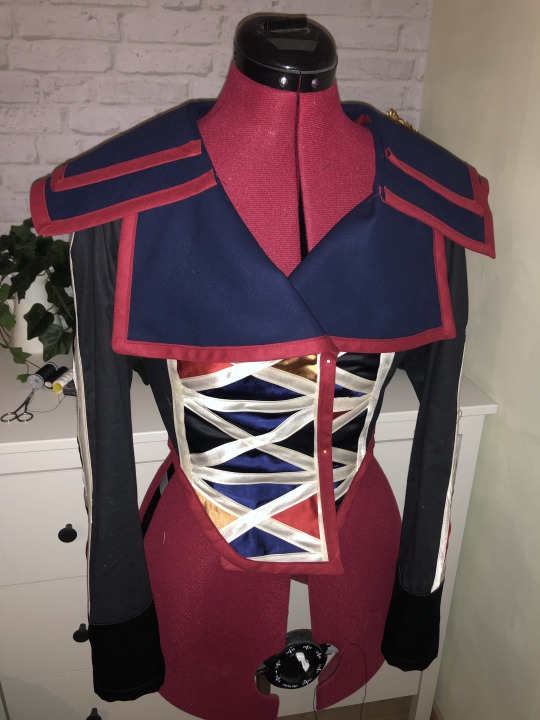
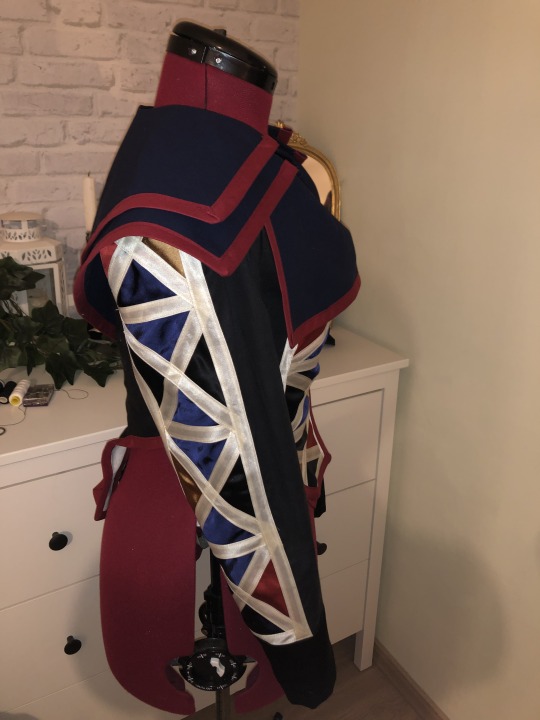
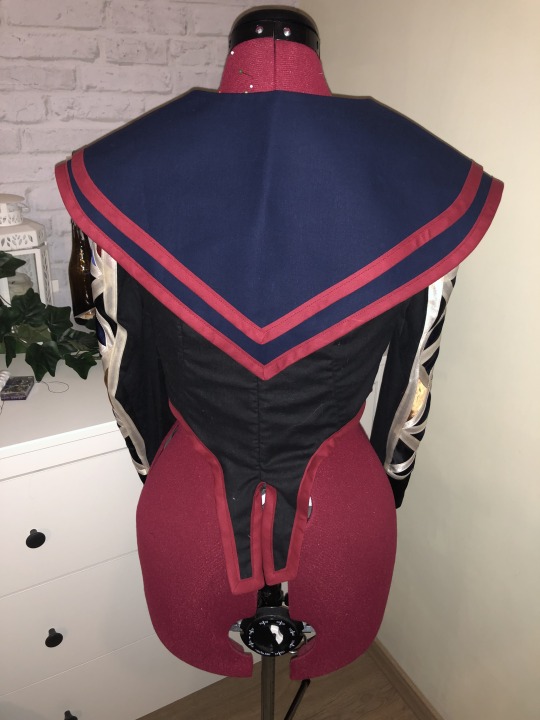
On a side note, upon rewatching the scene in which Lestat wears this outfit, I noticed that the back also had the colored panels. However, I feel like it's colorful enough as it is, and frankly, I don't have enough satin and tape left to do it, so I'm just going to leave it. I like it better this way.
Anyways, I'm really excited to finish this up soon, but I also ran out of red tape so I'll have to find some time to go to the sewing store to get some more. And I'm not entirely sure if I'm going to do an actual button closure in the front or if I'm going to fake it. The satin is extremely prone to fraying and I'm scared to add button holes to it, even though I'd planned to add them over the horizontal stripes. I'm going to have to find some fabric scraps and see how the fabric behaves, and if it frays I'm going to have to fake it with some hooks on the inside of the bodice. I hope it's going to look good either way!
Part 1 | Part 2 | Part 4|
#fashion history#historical fashion#iwtv#interview with the vampire#lestat de lioncourt#amc iwtv#sewing#redingote#georgian fashion#18th century#18th century fashion#18th century dress#1790s#1790s fashion#georgian#fashion
35 notes
·
View notes
Text
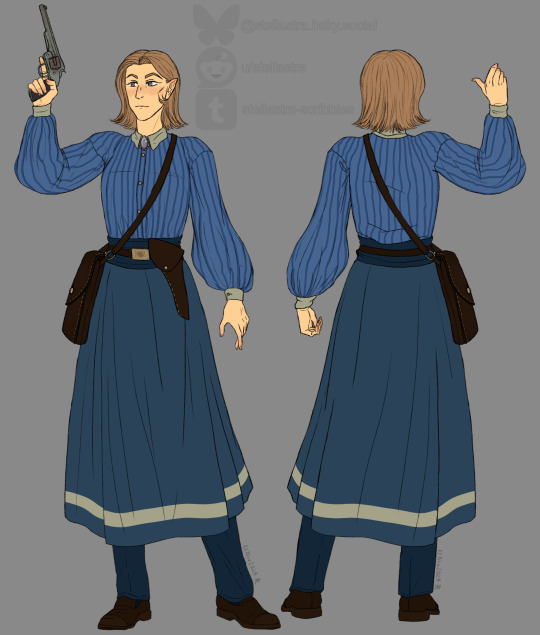
Finally completed the outfit reference for Jayna Stiles, a half-elven NPC follower from Arcanum: Of Steamworks and Magick Obscura.
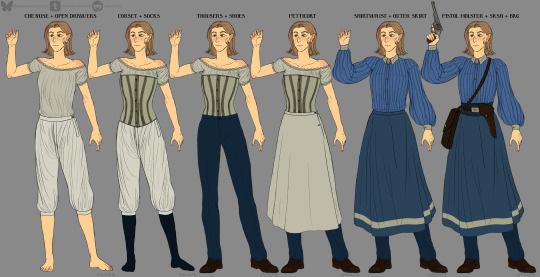
Outfit breakdown (or "outfit onions" as I like to call them lol~)
I really like Jayna Stiles and her backstory + goals of becoming a technological healer. I'm also a sucker for 19th-century fashion and I have an unhealthily large collection of reference books and a bunch of files saved from online museum collections (I've got about 22+ gigabytes of refs downloaded from the Library of Congress alone haha I need more hobbies).
More unrestrained detailed design ramblings below the cut~
Back on track, I really just wanted to design Jayna an outfit that suited her character more than her in-game sprites while also being practical for travel/adventuring.
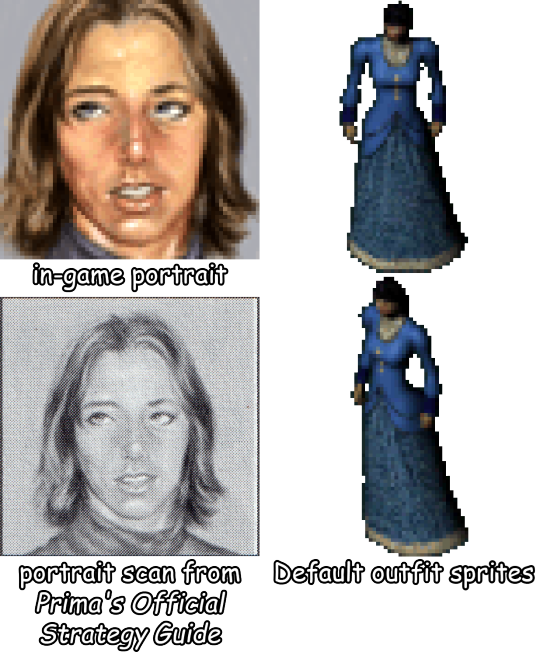
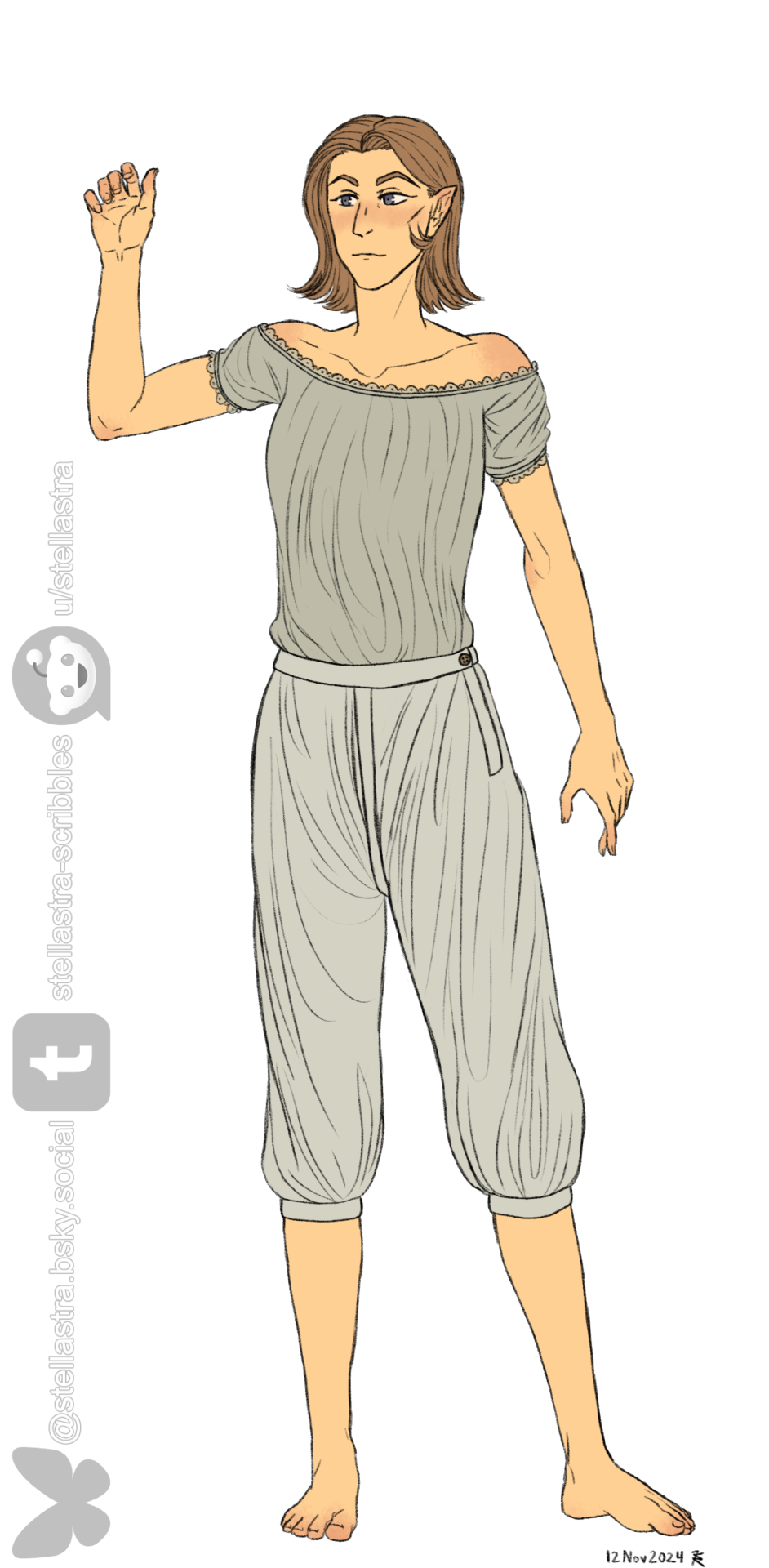
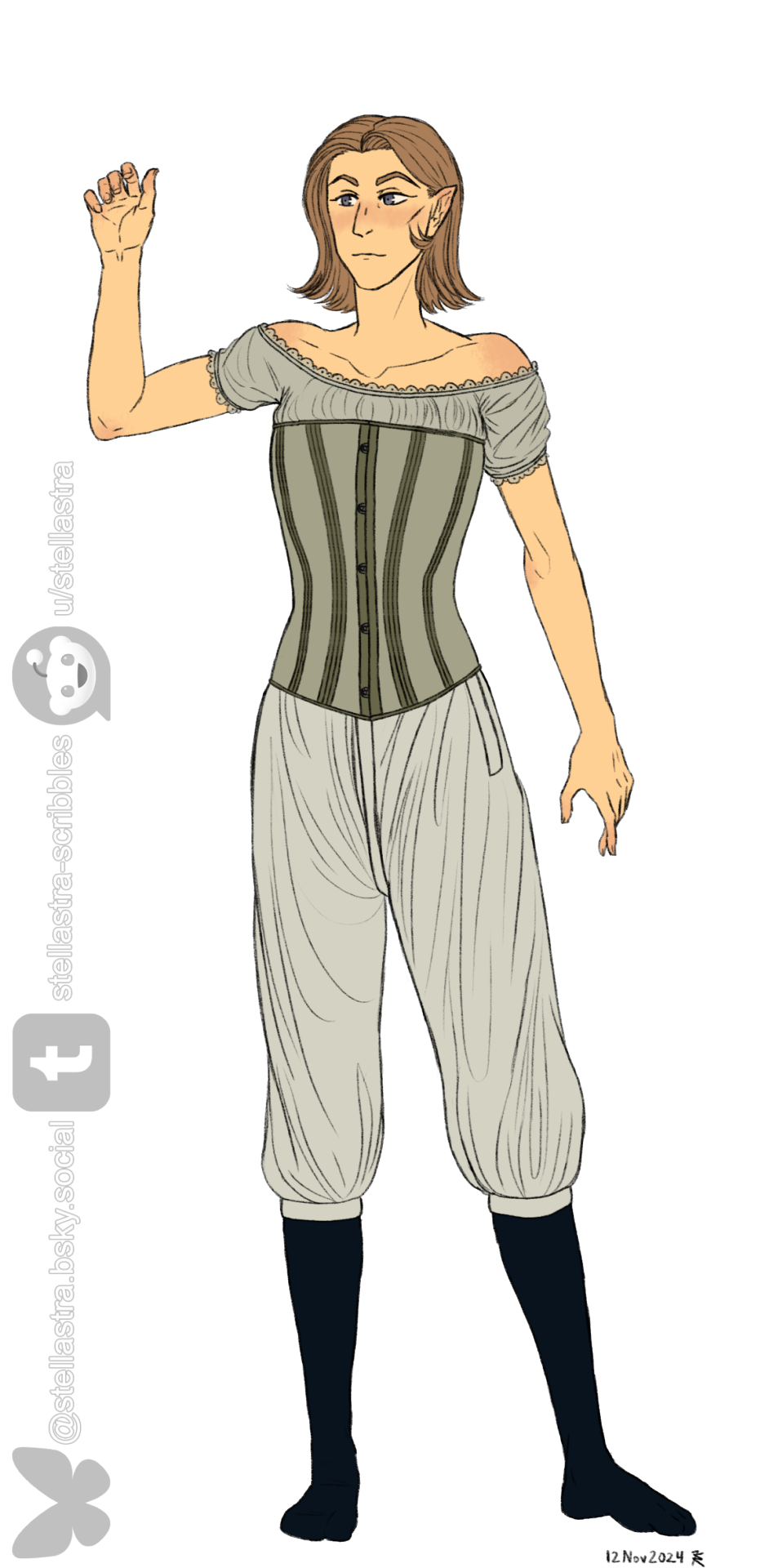
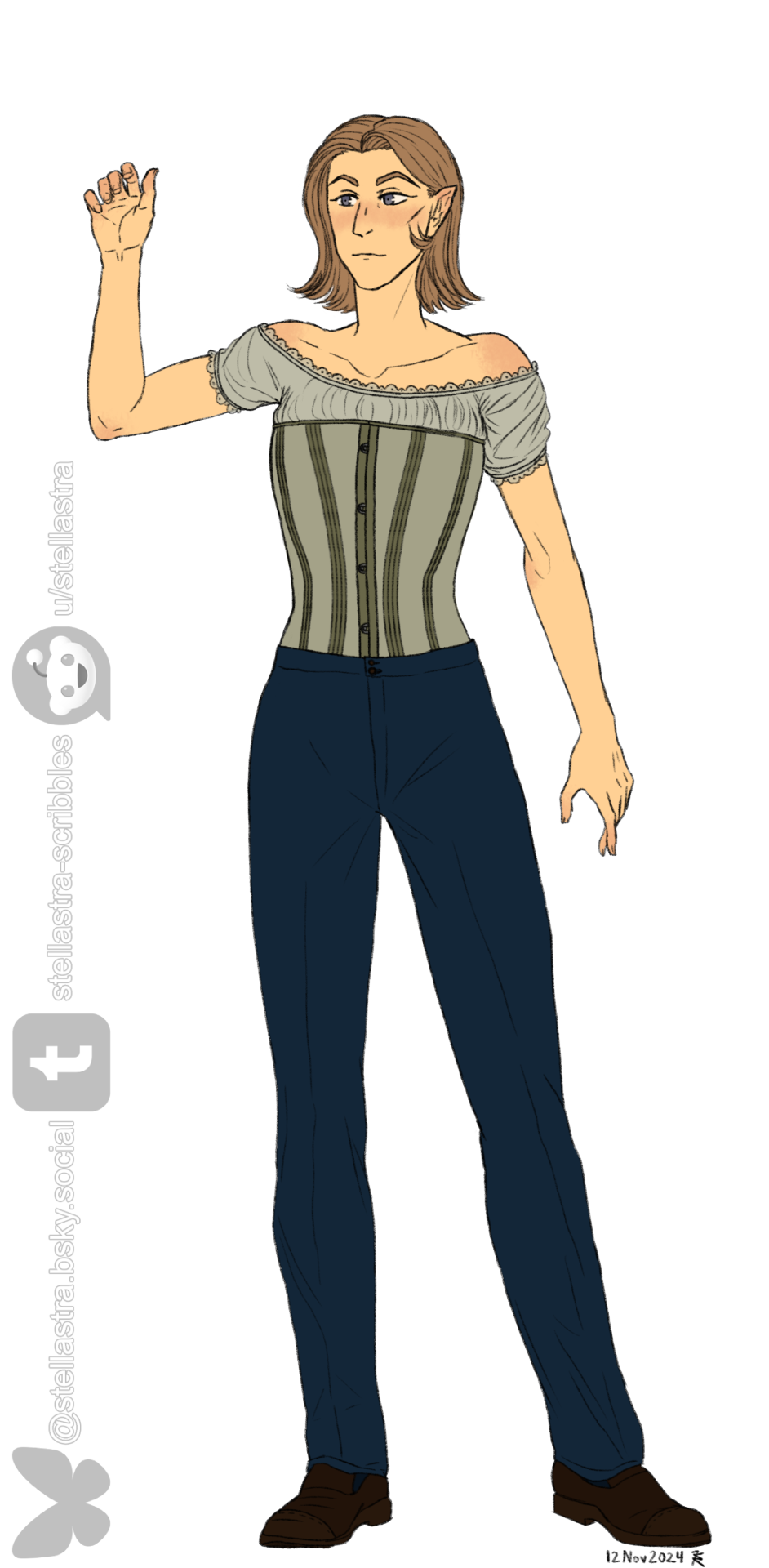
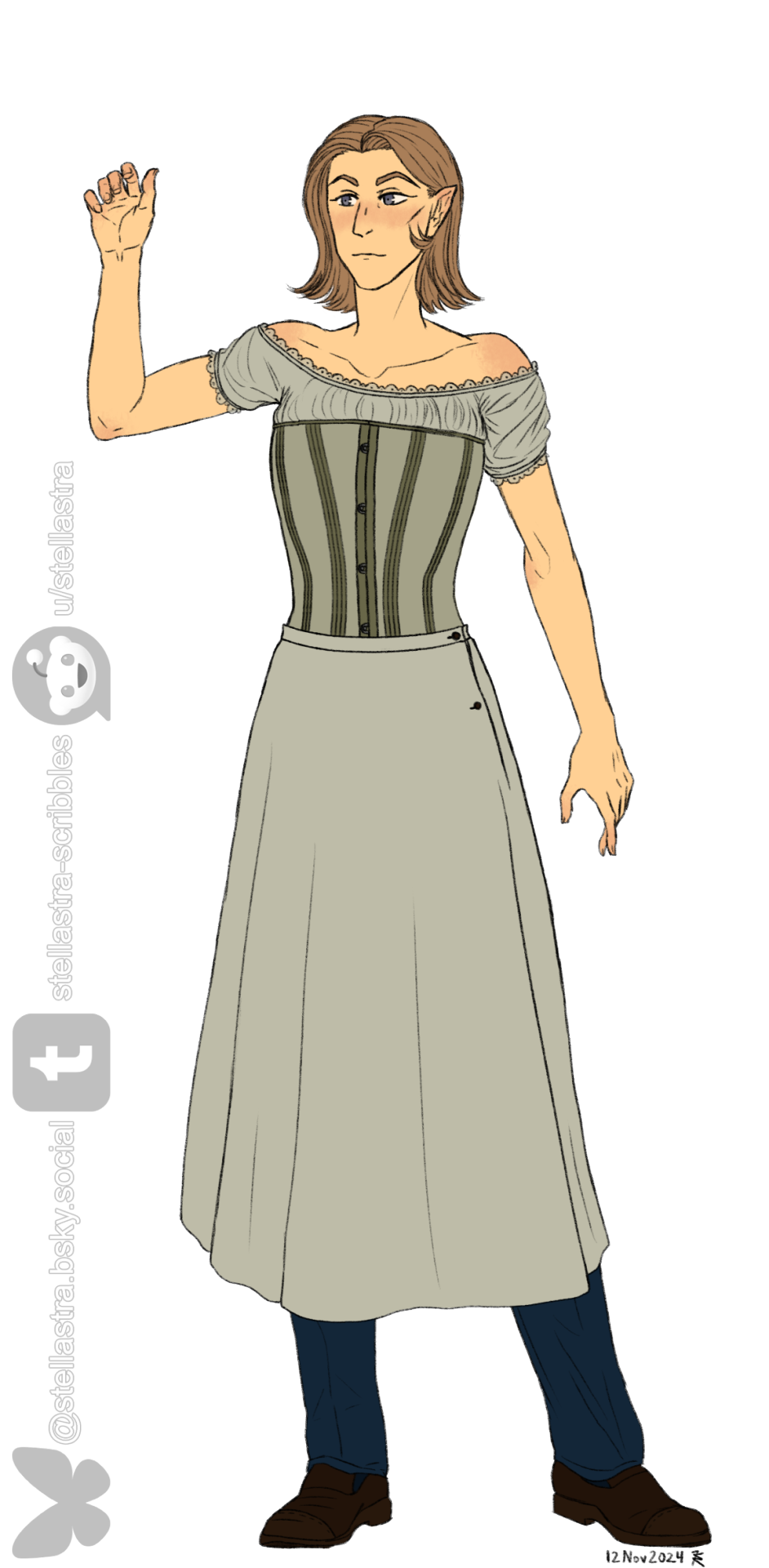
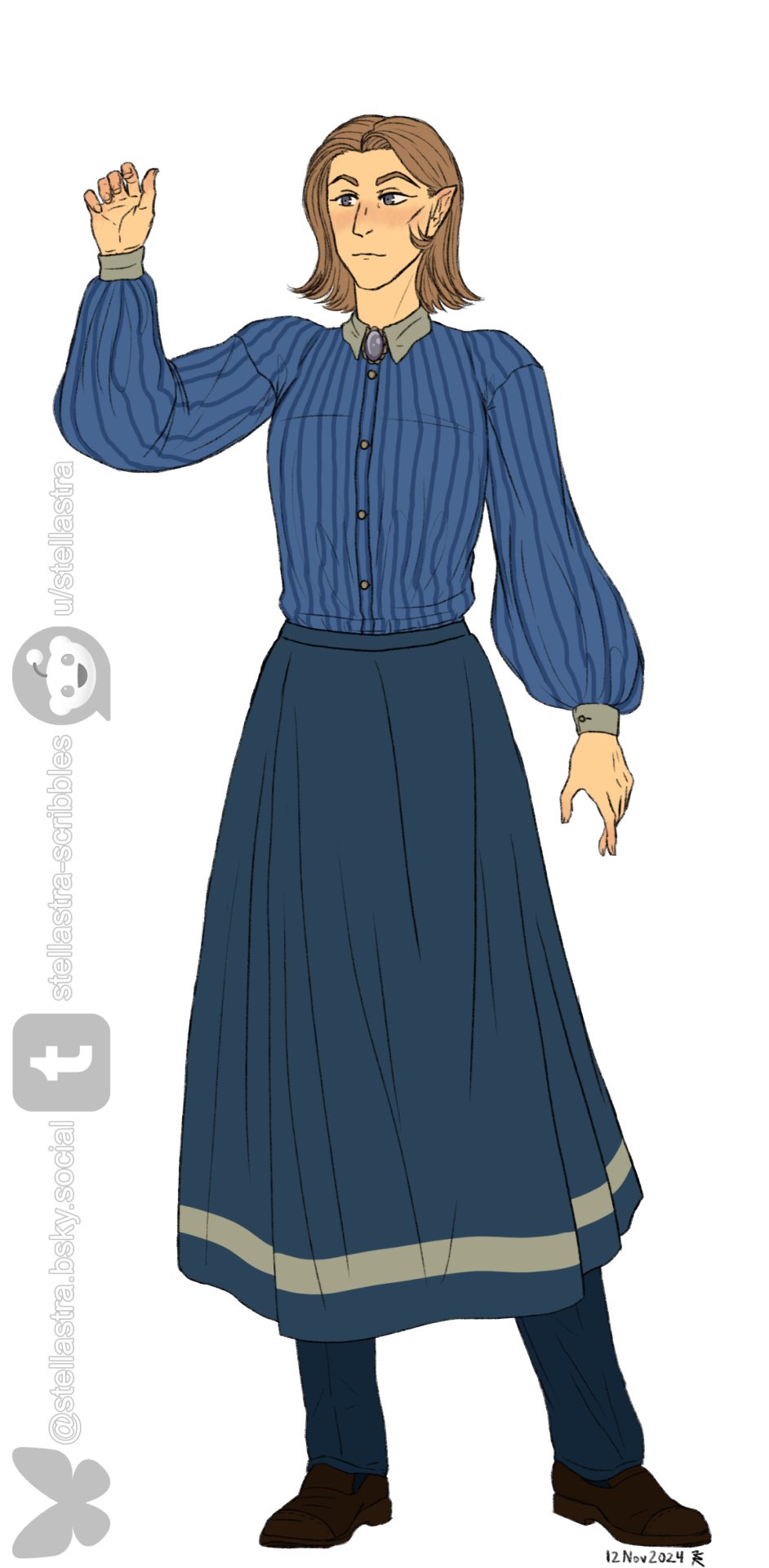
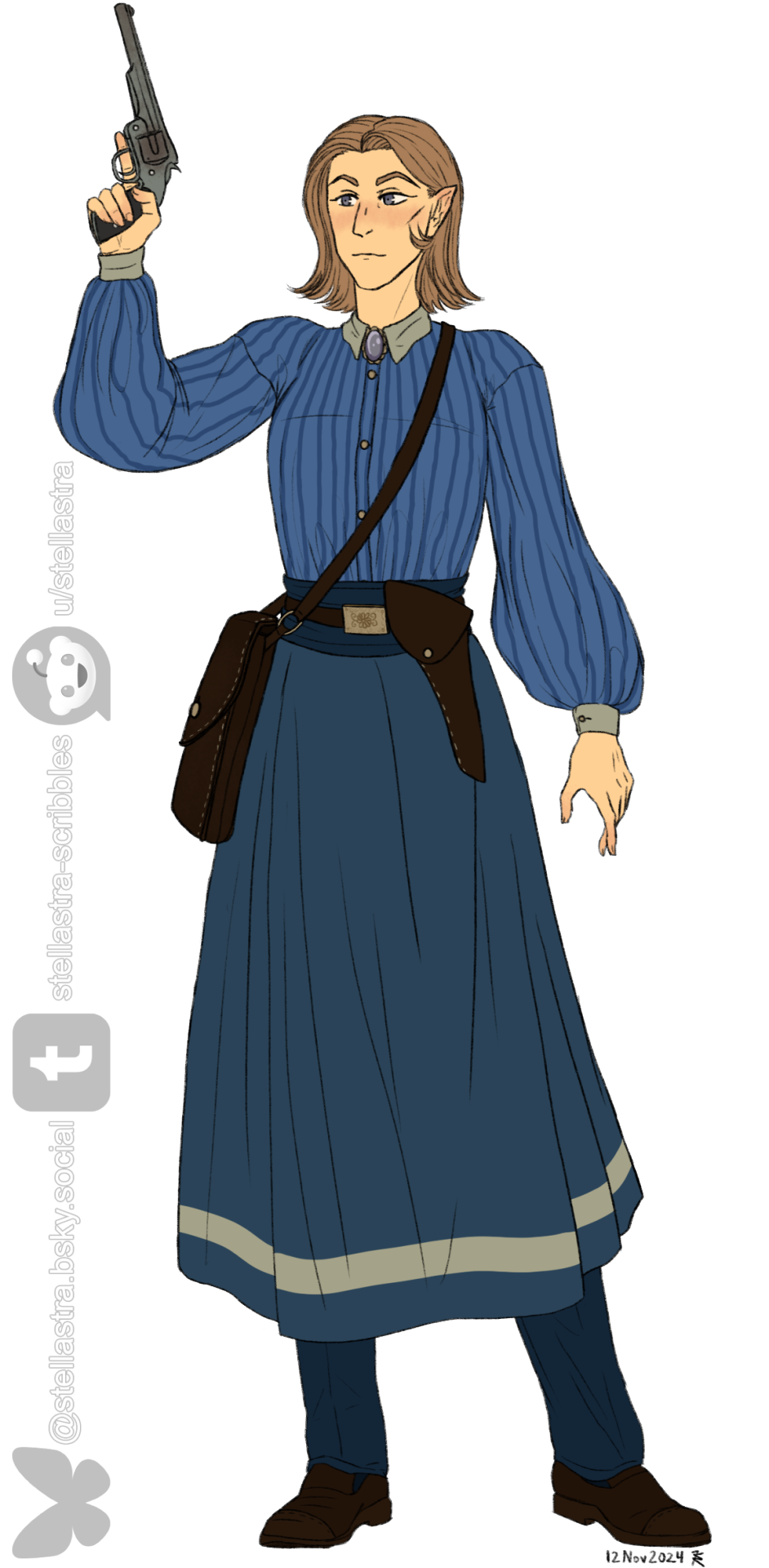

Individual layers. I pulled most of her colors from her default outfit.
Since Arcanum's starting year is 1885, I usually picture the "modern" sense of fashion in big cities like Tarant and Caladon taking cues from real life 1885-1890s western fashions (to give myself some leeway with references). Smaller towns can be a bit more dated, but I try not to go back further than the 1870s in most cases.

However, for a character like Jayna, who hails from Dernholm, I gave her clothing from references dating back to the 1850-1860s. I did this because Jayna says in her recruitment dialogue that "[her] parents weren't wealthy people, and [she doesn't] make much money here in Dernholm," so I took this to mean that she likely wears clothing to last, wearing hand-me-downs, makes her own clothes, and mending it over the years rather than buying new clothes.
Given that Dernholm (+ the Kingdom of Cumbria in general) isn't in the best state when the game starts, they may be behind the times and the latest fashions take longer to reach Dernholm.
Gar: “Alas, poor Dernholm! Once home to the legendary Dragon Knights, it has fallen on hard times since Praetor became king some 60 odd years ago. He despises all technology, and I think he's recently become sour on magick as well.”
Herkemer Oggdoddler: “For two generations Cumbria languished as an economically abused and technologically impaired backwater in the shadow of Tarant. Its once fine capital, Dernholm, has become a ruin.”

Layer 1 - Chemise + Open Drawers. I deliberately drew the drawers as fairly loose so as to not expose her without having to redraw the pose or resort to "Barbie doll anatomy."
Various resources demonstrated the chemise being tucked into the drawers or worn fully untucked/loose, but I drew it as tucked-in for the sake of reference visibility, so perhaps either one works in practice.

Layer 2 - Corset + Socks/Stockings. I picked a more "contemporary" (1880s) design for the corset as I imagine it would be a more custom-fitted garment. Plus, anyone who has ever worn bras will attest that a bra that properly fits is comparable to a good pair of shoes: never cheap out on it because if you take care of it, it will take care of you. Perhaps that same logic can be applied to corsets in ye olden days and historically-inspired fantasy settings.
For Jayna, despite the simplistic design, it might be one of the few luxuries she can afford for herself given the necessity of the garment for bust support.

Layer 3 - Trousers + Shoes. I was inspired by vivandières and Dr. Mary Edwards Walker, who typically wore trousers beneath their skirts. Dr. Walker was a "surgeon, women’s rights advocate, abolitionist, and spy, [and] the first female U.S. Army surgeon during the Civil War." Since Jayna is an aspiring technological healer, I feel like an allusion to Dr. Walker and her practicality was appropriate.
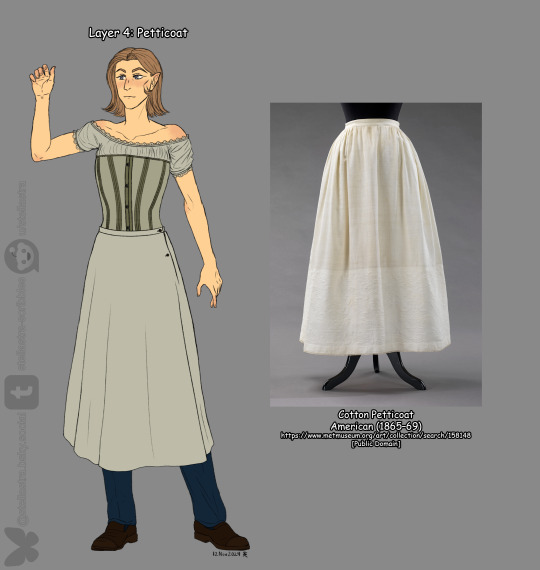
Layer 4 - Petticoat. It's just something to fill out the skirt volume a tad. I considered adding a corset cover in this layer but I did like having the upper outline of the corset somewhat visible in the shirtwaist layer to illustrate her living situation (aka she doesn't have one or just has a poor-quality one). As a modern-age woman, I think this this all already looks like a laundering nightmare to wash by hand.
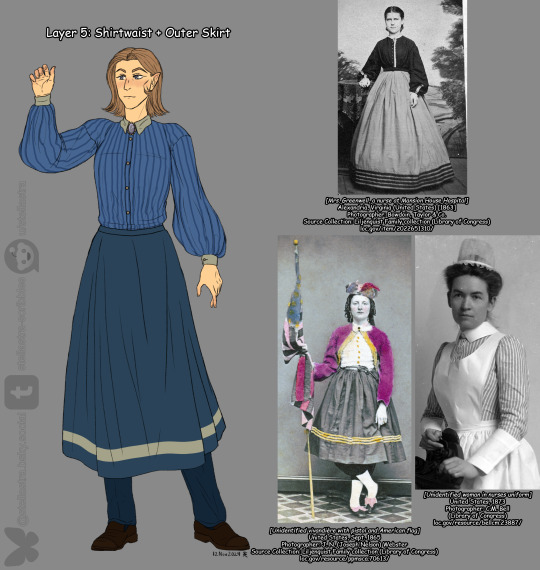
Layer 5 - Shirtwaist + Outer Skirt. I really like the shape of the 1860s Garibaldi blouse's sleeves (I think these are bishop sleeves? correct me if I'm wrong...) and the stripes allude to some 19th century nurse uniforms. I initially went for a plaid pattern but that was a pain to draw and using a pre-existing plaid brush/pattern just didn't look as good as I wanted it to be.
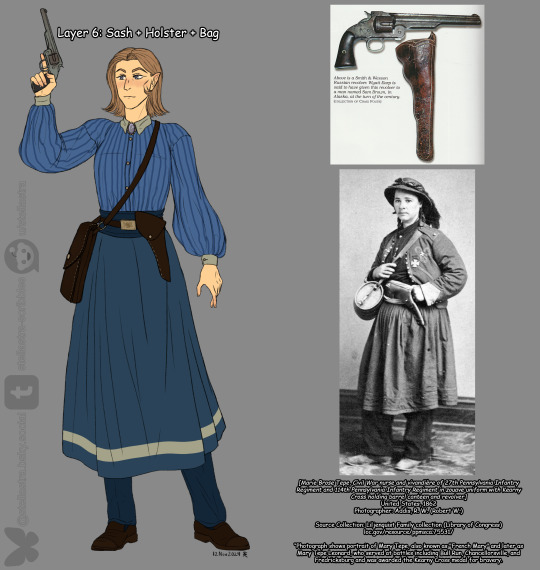
Layer 6 - Sash + Pistol Holster + Bag. Given Jayna's goals of becoming a tech healer, I took design cues from vivandières, who were 19th-century women attached to military regiments, with a few known vivandières being nurses (like Anna Etheridge).
However, rather than lifting the vivandière look completely, I imagine Jayna would attempt to replicate the silhouette with her own clothes. The bag is a bit of an amalgamation of various 18th-19th century hunting/frontier bags, so I apologize that I don't have a direct reference image.
---------------
Of course, in the end, I did take some liberties with the outfit so it's not completely historically-accurate, but that's okay since Arcanum is a fictional universe.
I guess I should've prefaced that I'm no expert on historical fashion, just a casual enthusiast who thinks "ooh old dress is pretty!"
I just wanted to see how far I could go before I had to make some concessions, such as:
Jayna's hair is short and worn loose while irl Victorian women typically had long hair and wore them up (there were documented exceptions of course). Many portraits for both female player characters and female NPCs across all in-game races show short hair and loose long hair, so let's just assume that 19th-century Arcanum has more relaxed feminine hair standards compared to the real-life 19th century western world. Also, irl 19th-century rural women did sell their hair for money, so maybe there's something to apply to the world of Arcanum with that. Or maybe the short-hair craze just hit Arcanum a few decades early *shrug*.
I initially planned to give her gloves, but many resources show vivandières not really wearing them, preferring to go barehanded.
The clothing colors may be a bit too saturated for the era I took inspiration from, but I wanted to stay somewhat faithful to Jayna's original sprite colors.
I did simplify some garments down for the sake of me having to draw enough layers as it is lol. Sorry if the lace wasn't fancy enough or that she doesn't have headwear. ¯\_(ツ)_/¯ Sometimes you just wanna finish a project and be done with it.
hoo boy, that was a lot
Thank You For Coming to My TED Talk :)
Now go play Arcanum: Of Steamworks and Magick Obscura~
#stellastra's art#Arcanum#arcanum of steamworks and magick obscura#arcanum: of steamworks and magick obscura#Jayna Stiles#half elf#historical fashion#steampunk fantasy#character design#victorian fashion#19th century fashion#unashamedly tagging this bc this game doesn't get enough love#to the like 10 or so Arcanum fans here on tumblr - this is for you!
21 notes
·
View notes
Text
Aunt Nerine: inspiration and design thoughts
You can find more information on aunt Nerine in her intro post
Character inspiration
Figuring out aunt Nerine was a very different process to Emi, since this time I actually was pulling inspiration from Disney (and other) sources. Like, you could pretty much say she's twisted from the general concept of a fairy godmother.
Putting together her main influences, the collection would look something like this:




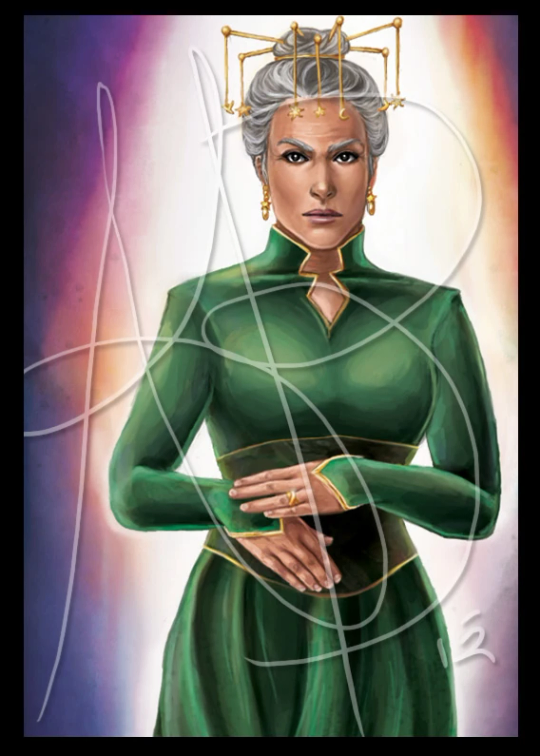

Which would be:
The Fairy Godmother from Cinderella
The three good fairies from Sleeping Beauty
Maleficent from Sleeping Beauty
Fairy Godmother from Shrek 2
Cadsuane Melaidhrin from The Wheel of Time (can't believe she snuck in smh)
and finally, Cupid
(so, is now a terrible time to admit that I've seen neither Cinderella nor Sleeping Beauty? oop)
So, looking at aunt Nerine, I'm sure you all can spot the visual similarities.

(as always, this particular art belongs to moonyasnow)
A vaguely historical dress (I'll get back to this later) like the fairies from the Disney movies, hair similar to Cadsuane's, wings similar to Cupid (& Shrek's Fairy Godmother to a lesser extend), a wand, but the end is a heart like Cupid's arrow sometimes is portrayed as. She also kinda shares the sparkliness with Shrek's Fairy Godmother.
Personality-wise – she thinks she is being helpful, but she is wilful and doing what she herself wishes to do or thinks is the best course (Cadsuane anyone?). She's also... not above being petty or getting back at you if she's slighted, and also has magical power in spades. These are all traits that certainly tie to at least one of her influences.
Plus just the obvious fairy godmother -like character she has in general, even if somewhat twisted in true twst style.
More detailed design notes
Not gonna lie, I had a lot of fun putting together aunt Nerine's outfit and looks. I wanted to pull from something historical, even if I wasn't necessarily going to stick to the historical styles too closely. Still, finally putting to use all those hours watching historical costuming youtubers, lol.
A fair few pics and stuff in here, so putting this below the cut for length.
Her hair actually started off with me thinking of like an Edwardian school teacher. So very voluminous, with a nice proper bun on top. It was only later that I realized that I was kinda going for Cadsuane's hair, too, especially once I realized that I wanted to add some extra bling.
So, this was the vibe I was going for when thinking about the hair:


Y'all can find more pics from this set here
The wings, as I said, were pulling mostly from Cupid imagery. And while it doesn't show in her design, there's just something very funny to me in the wings being something she just wears for the looks, instead of them being an actual part of her.
Gotta have some whimsy when you've been around as long as she has, you know? (No wonder she and Lilia get along, can't remember anymore if it was dio or moony who first suggested this point but you were so right.)
For the pink collar / chest piece I was thinking of a some sort of an partlet + Medici collar combo. A partlet is basically a neck/chest covering and its own garment, so I'm thinking in aunt Nerine's case it wouldn't be a part of the dress, but something that she can swap out. The same swappability goes for the collar and for the sleeves, to keep with the vaguely 16th century fashion vibes she's got going on.
This pic is what I mostly referenced for the idea, though with a lower collar that'd still give room for Nerine's earrings & hair.

The dress itself is definitely pulling from Elizabethan vibes. This is the particular image I used for inspiration, as it shows the shapes well. A conical bodice with a curved upper edge, narrowing out to the waist with a point that emphasizes the illusion of a narrow waist – especially when combined with the full, layered skirts.

I did decide to forego the shoulder rolls and Elizabethan ruffles, tho.
As for the spider web pattern on her skirts...
Since Nerine has a bit of a sona in her too (to let out my impulses to meddle with charas getting together, lol), I wanted to give her a name somewhat reminiscent of what I go by here. I originally thought of Nerrie (a name I've used elsewhere), but in the end figured maybe we could do with a bit more separation between the creator and the creation, lol.
So, I looked for flower names starting with ner – and found Nerine, aka spider lily. And with the name the spider webs became pretty much an obvious motif to include – both because she kinda tangles people in her webs, and because she's not just all sunshine and roses and love love joy joy.
And if you wanna find out what Moony had to work with (other than the reference pics & my rambles), here's the sketch I sent their way:

It really is wonderful what people can do when they actually know what they're doing, huh?
Tagging @diodellet (ty for enabling me to ramble!) @moonyasnow @scint1llat3 @bibi-cha
If anyone would like to be added to / removed from aunt Nerine's tag list, just let me know!
10 notes
·
View notes
Text
while i was away the other week, i picked up a potential trim for my lady Stede dress, and i wanted to talk a bit more about it with you guys and see what you think !! (you can skip to the end for an opinion poll if you dont wanna read all the background spiel!!! tldr: do we like what i picked?)
so, Stede's costume is not particularly historically accurate, but the use of trim between mens & womens fashion is completely different anyway, so im not too worried about trying to find something that matches 100%. i mostly want something that brings the same effect to the garment, particularly in the colour. i went and found some high def images, so you can sort of see the structure of the trim.
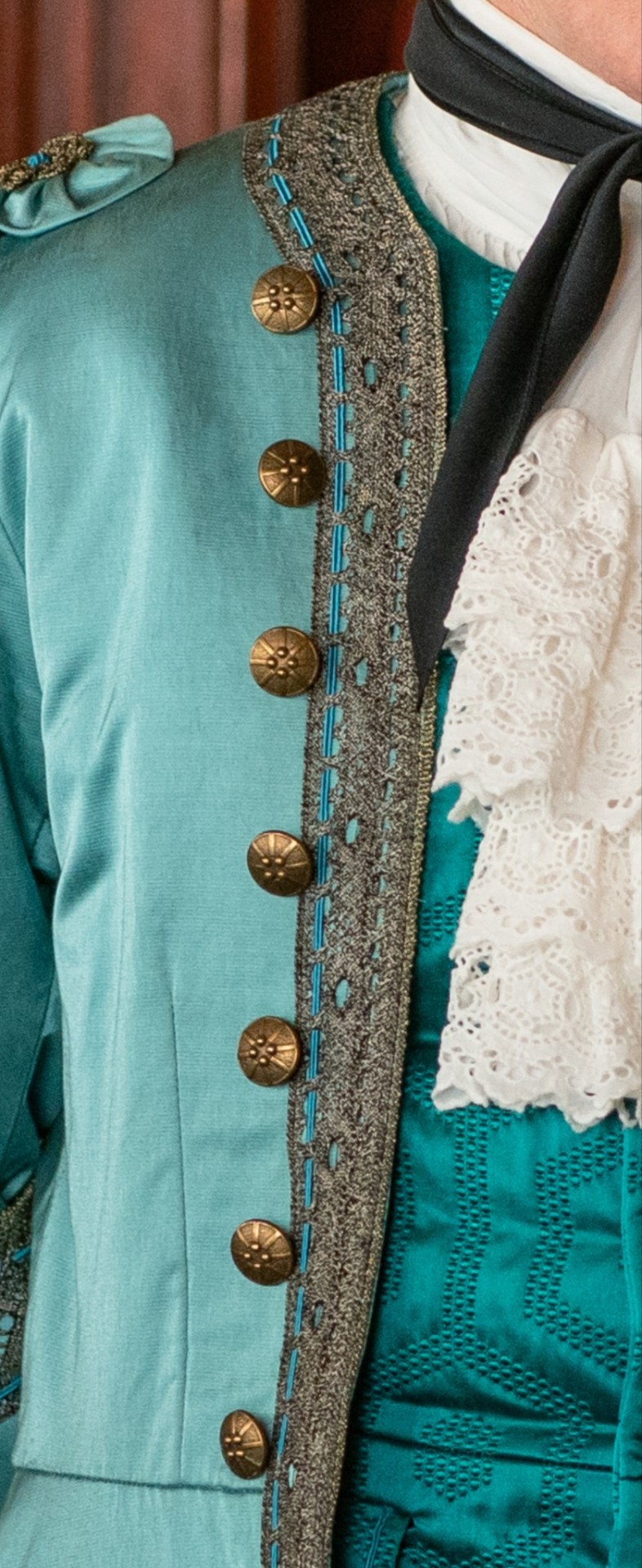
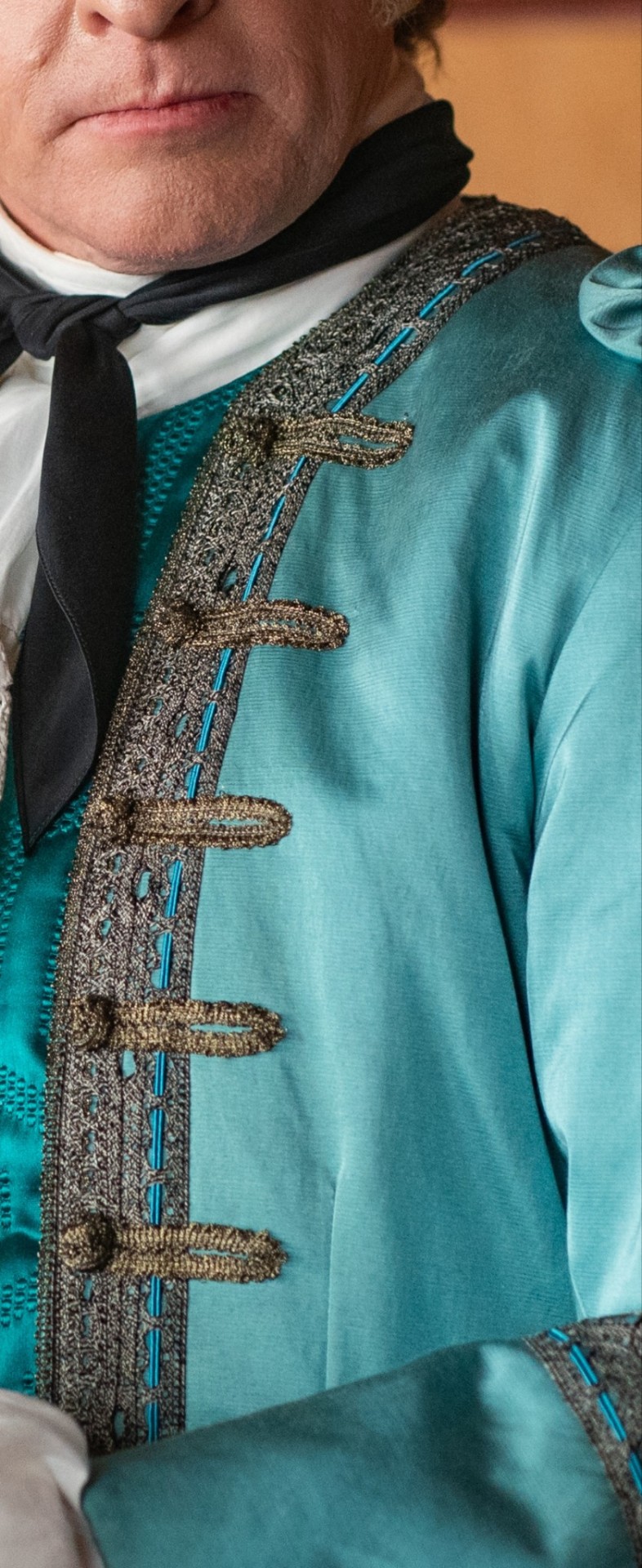
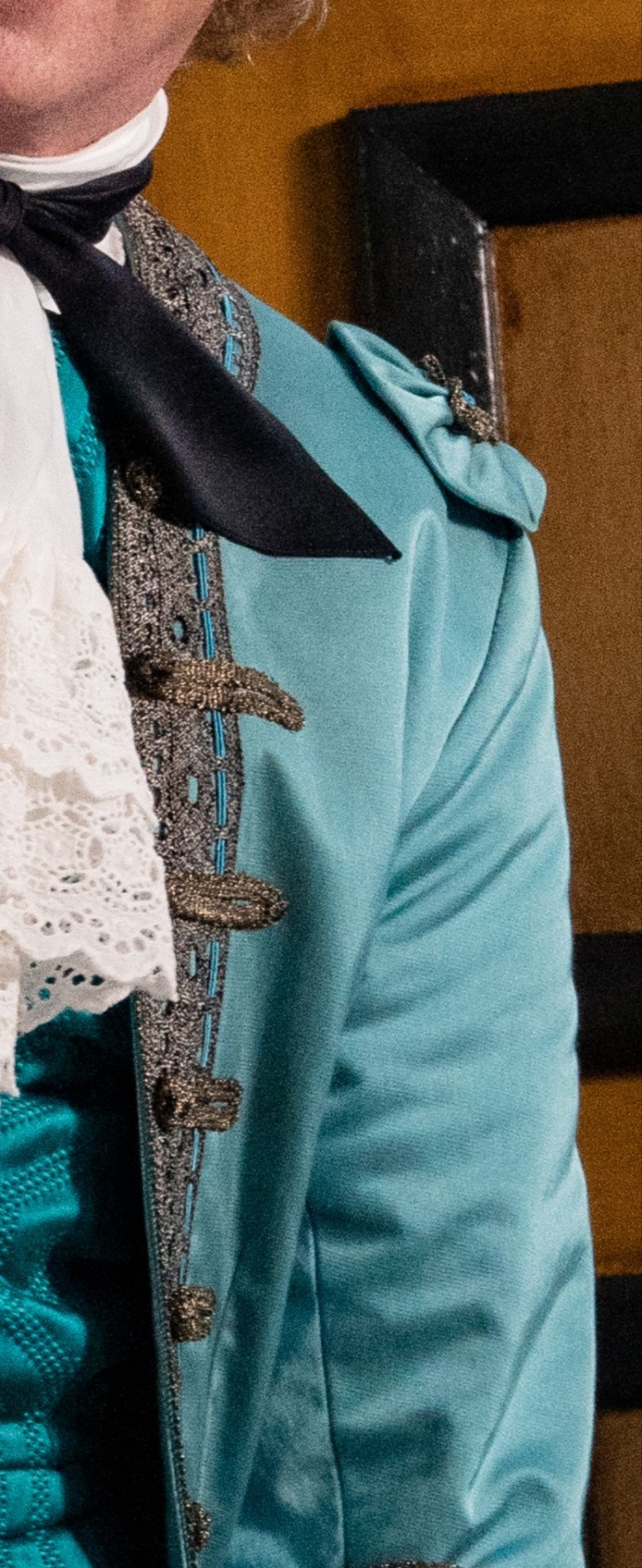
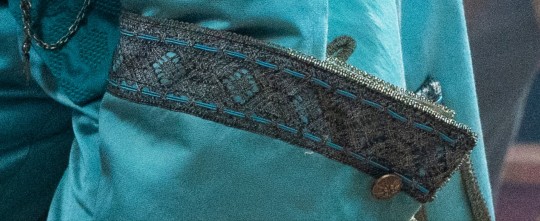
The colour is somewhat hard to pin down, but i tend to see it as a sort of antique gold colour? it looks to me like tarnished metal (but i would love to hear about your opinions on the colour!)
The trim is much more subtle on the style of dress im making- most of the decoration is created through pleated stripes in the same fabric as the dress, with the decorative element lining the edges (and occasionally running down the centre). looking at extant examples, ive seen many different shapes of trim, though most of it seems to be looped cord or "fly fringe" - loose filament tied into little puffs or flowers (its super cute but hard to get a hold of and i dont think i care enough to make it)
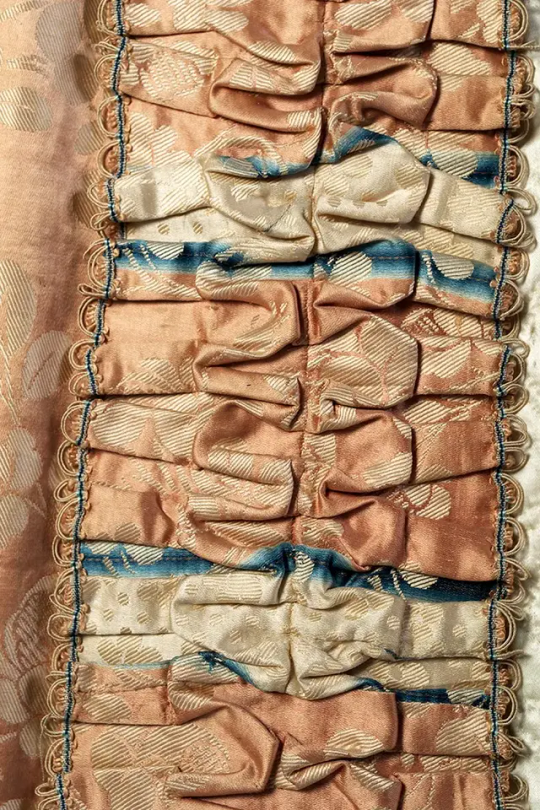
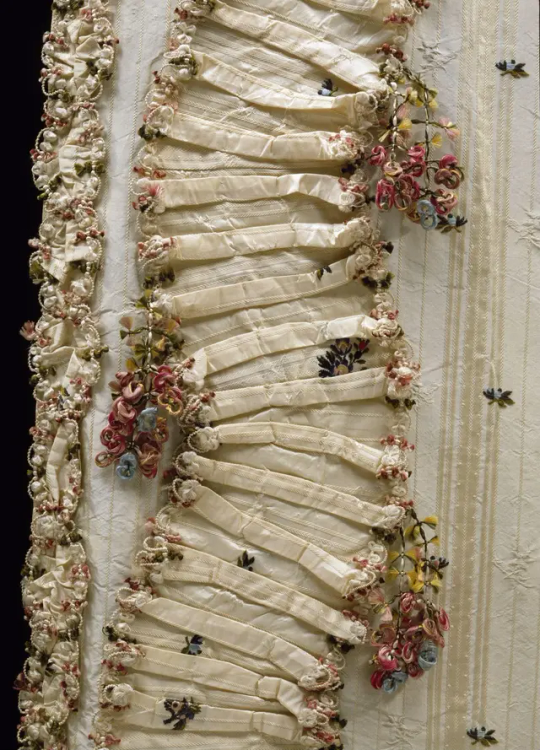
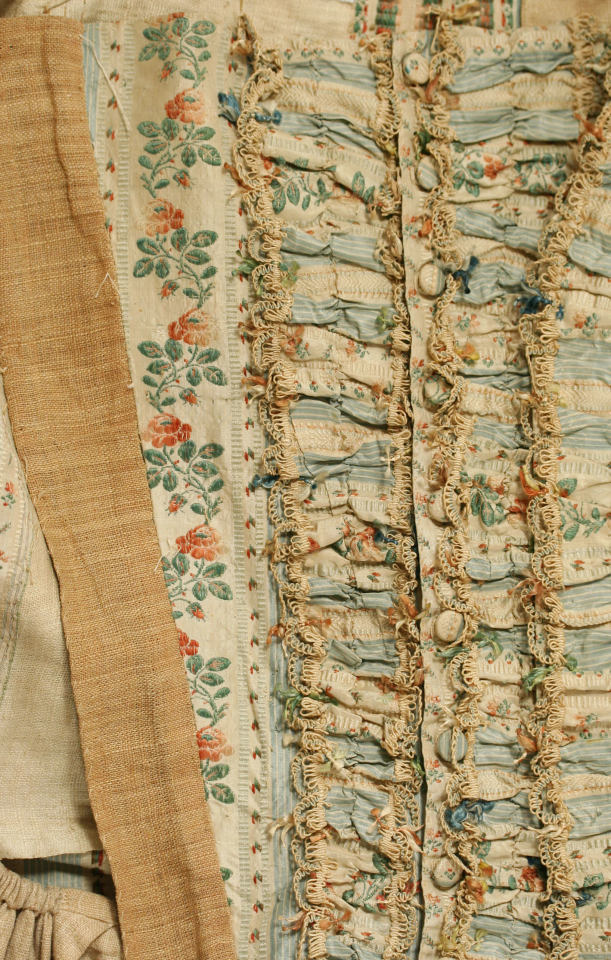
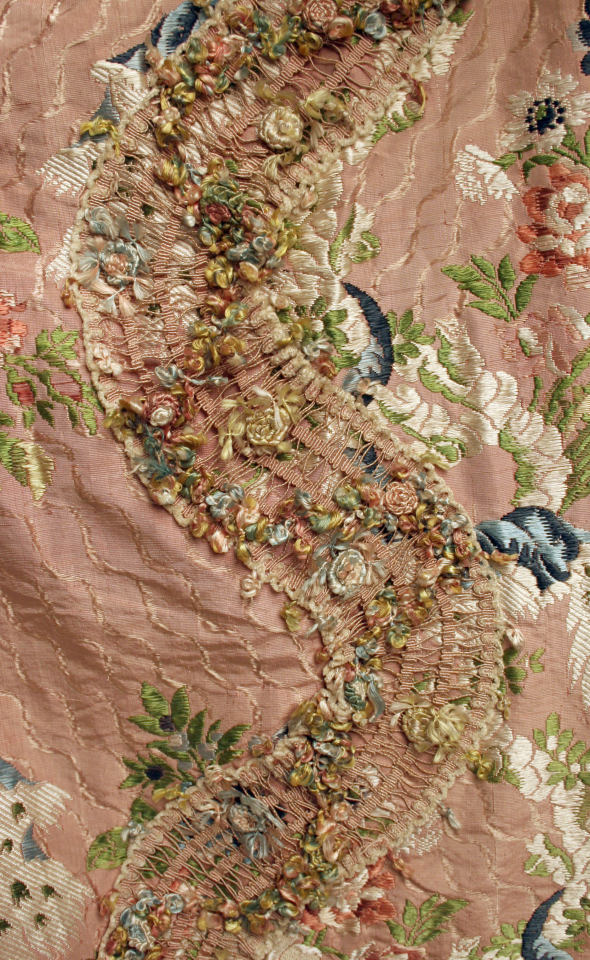

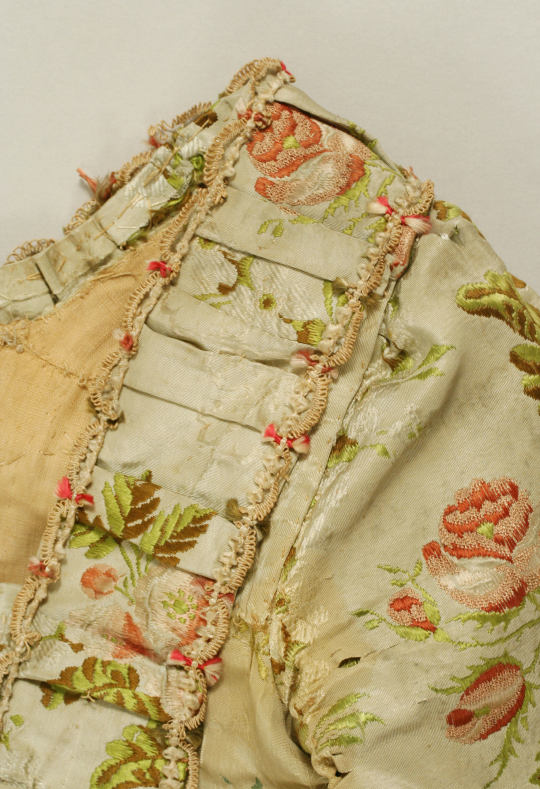
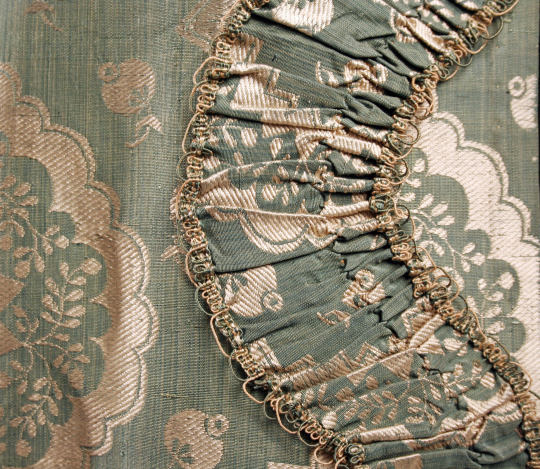


im not quite sure how im trimming this garment yet- i dont want to commit to anything until ive played around with what looks good on the actual dress, but i know i want to do at least some of this pleated design on there, so these styles are what i went out with in mind.
(ok, context established, onto my specific picks!) i really struggled to find trims i felt would work for this project- i wanted gold, but everything i was finding was too bright and shiny and not at all what i was going for. I ended up picking two things in the same dark gold colour that felt a bit more worn in, but definitely needed work to get the shapes i was looking for- one i think ill dismantle entirely and use the cord to make something new, if i end up using these.
the other was much closer to the kind of thing i wanted, but still needs work. it had two lines of loops and my plan is to remove one of the lines to create something more like the looping of the historic trims. ive pinned one line out of the way in the pictures below to give you a bit of a better idea of what i want, but please know this was a 5 minute edit, and the final result may be different!! (i also want to add that i dont think ill leave the border edge as wide, either- i want the trim to be a hint, not overwhelming)
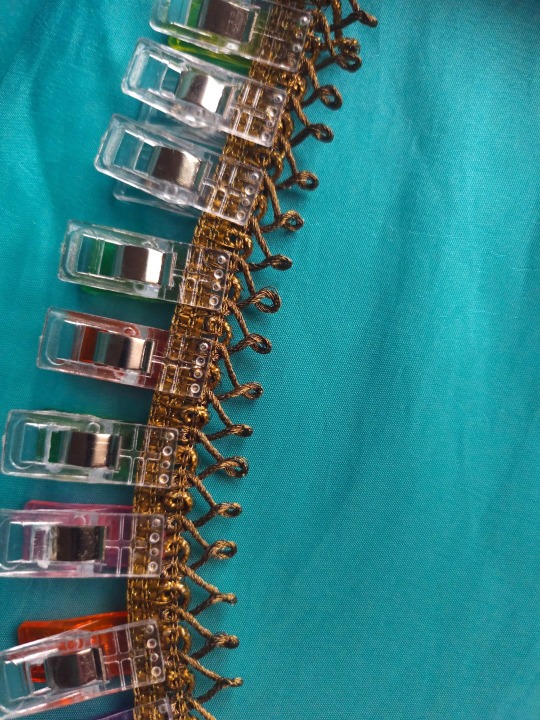
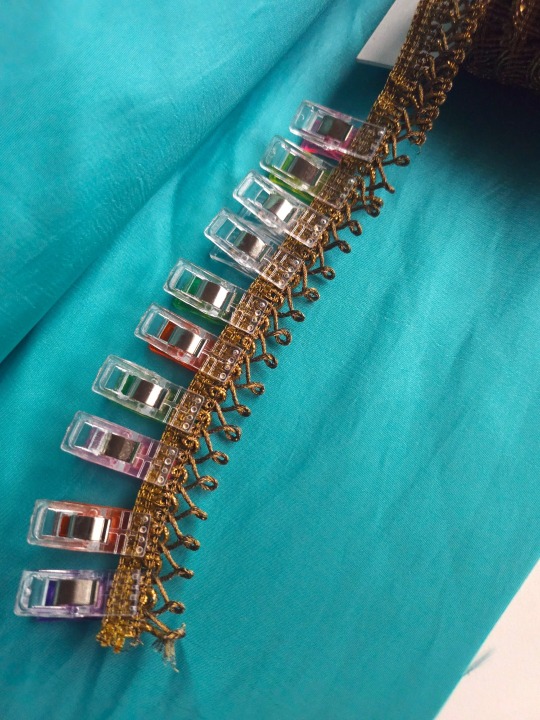
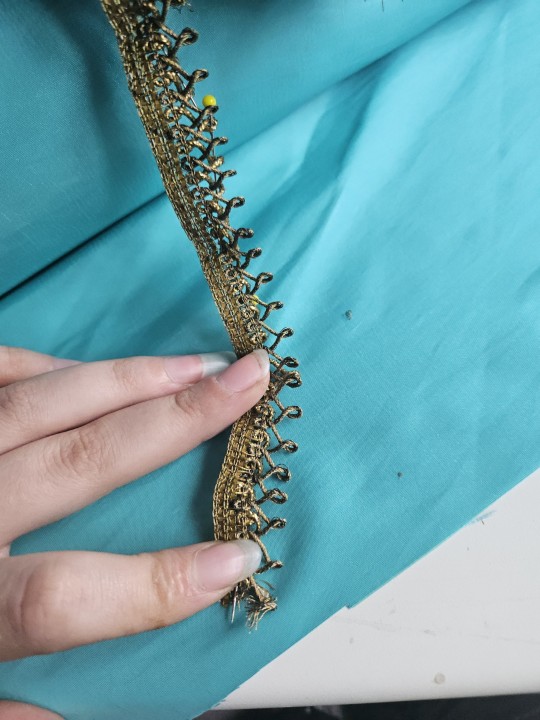
(these images have been edited a little to try and capture colour accuracy, as my phone Did Not want to make the blue blue :/ the last image is the most accurate to the trim, i think)
i think my pick was absolutely the best option out of the ones i saw... only now im looking at it with my fabric, im not sure. it was the best kind of gold colour they had, but i feel like stedes is even darker and cooler in colour, almost a brown-grey tone. (honestly, this one is pretty brown when you look close, but what matters is the bigger picture, so :/ ) it feels to shiny and sparkly, and like it might stand out in the wrong kind of way.
i want this dress to feel like a genuine historical garment first and foremost, id rather it look cohesive and intentional than be accurate to the show and im doubting myself with this trim- but also i know it was by far the best option that i saw when i was actually looking at hundreds of gold trims... so, what do you think?
#i have more notes on my thoughts about the design of this dress but i did want to keep this... topical; if not exactly short#i want the pleats definitely. but im not sure about the rest. i think filling space is Key to making plain fabric française look good#theres puffs and wreaths and... ive got a lot of ideas but ill see when i get further in what will actually work#anyway#i tried to include every opinion i thought people could have but i also. dont know what people are thinking#i would love feedback either way !! i think this is kind of nuanced as a discussion and a poll cant always cover it all#but most people. prefer to click the button and not /tell me/#sewing#poll#historical dress#costume#ofmd#our flag means death#stede bonnet#cosplay#design#pathetically begs for ur input into my costume 🙏🙏🙏 idk#also i think this sounds very negative to this trim but its because im doubting myself. vote with your heart boy. do not listen to my tone#Lady Stede Build
16 notes
·
View notes
Text
BARRAYARAN COSTUME DESIGN
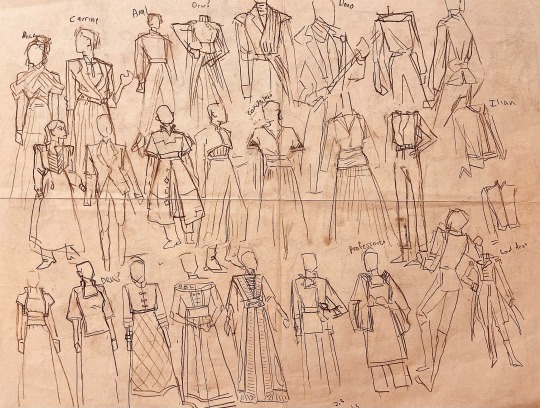
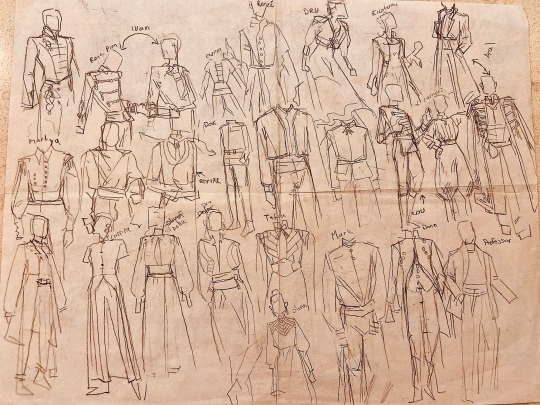
The process for costume design:
Had fun looking through a whole bunch of reference images to try to create a costume set that reflected the strong sense of tradition with midieval-esque holdovers from hand textiles that would have had to be the norm during barreyars period of isolation, while also accounting for the wealth of the current barreyaran aristocracy and their access to modern galactic trends and clothing. I also didn’t want the midieval influences to be generic-fantasy-vaguely-european-bulshit, so I also tried to find reference images with styles, patterns, and silhouettes that where somewhat reminiscent of the French, Russian, and Greek cultural heritage barnyard first settlers may have brought with them. That being said, it wouldn’t make sense for any of these traditional garments to have been preserved with 1-for-1 accuracy from there earth origins over the many centuries (cuz like, irl traditional dress in these countries is less and less common) so I didnt want to just copy exactly historical garments.
OH! And then I also had to make sure the men’s clothing also reflected the pseudo-military affectations which Bujold has mentioned in multiple books as being popular in menswear amongst the vor cast. (Ex: the formal riding boots, and the two swords carried at formal events, or less formally vor “town clowns” also wearing casual clothing reminiscent of a military cut.) but! In order to do this, I had to think of both what would have been military uniforms both in isolation-barrayar and modern barrayar, and which aspects of each set of military uniforms would be incorporated into modern men’s fashion. Would any women’s clothing also reflect this warrior trend?
Finally, since all of this costume design was brainstorming for the dinner party scene, I wanted to make sure that the clothes matched the personalities of the people wearing them. Like aunt Alice and Professors Vorthis are both middle aged Vor-caste women, but will have vastly contrasting style. Alice being alice, her clothing will likely be both perfect for the occasion while also a sleek and elegant combination of the leading barreyaran fashions, while also giving a nod to traditional barreyaran costume at times as she is a representative of both the state and her old-vor house. The professora on the other hand, will probably opt for something comfortable and cozy, while not especially showy, as she is more concerned with her studies and gardens and is not super involved in the Vorbarra-sultana social scene.
Some of the reference images I used:

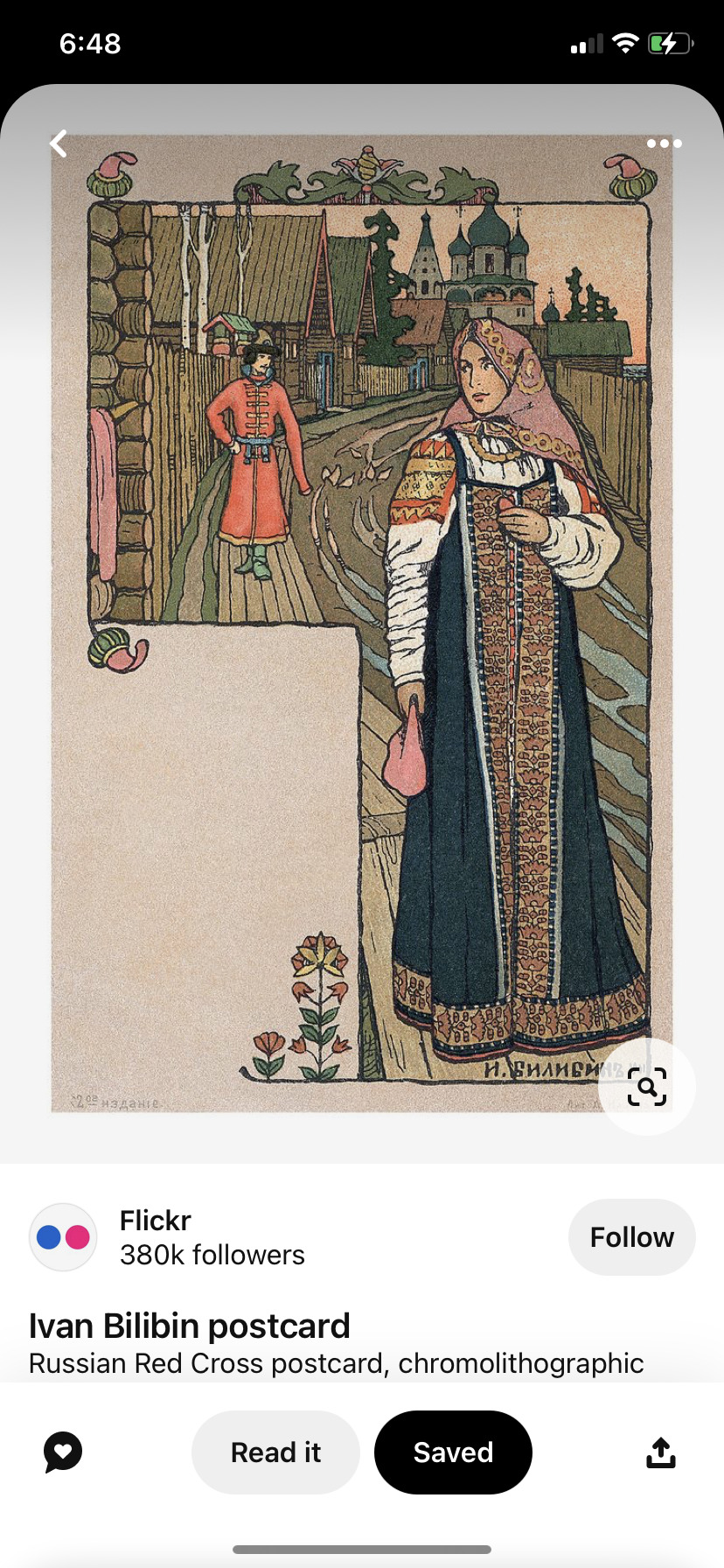
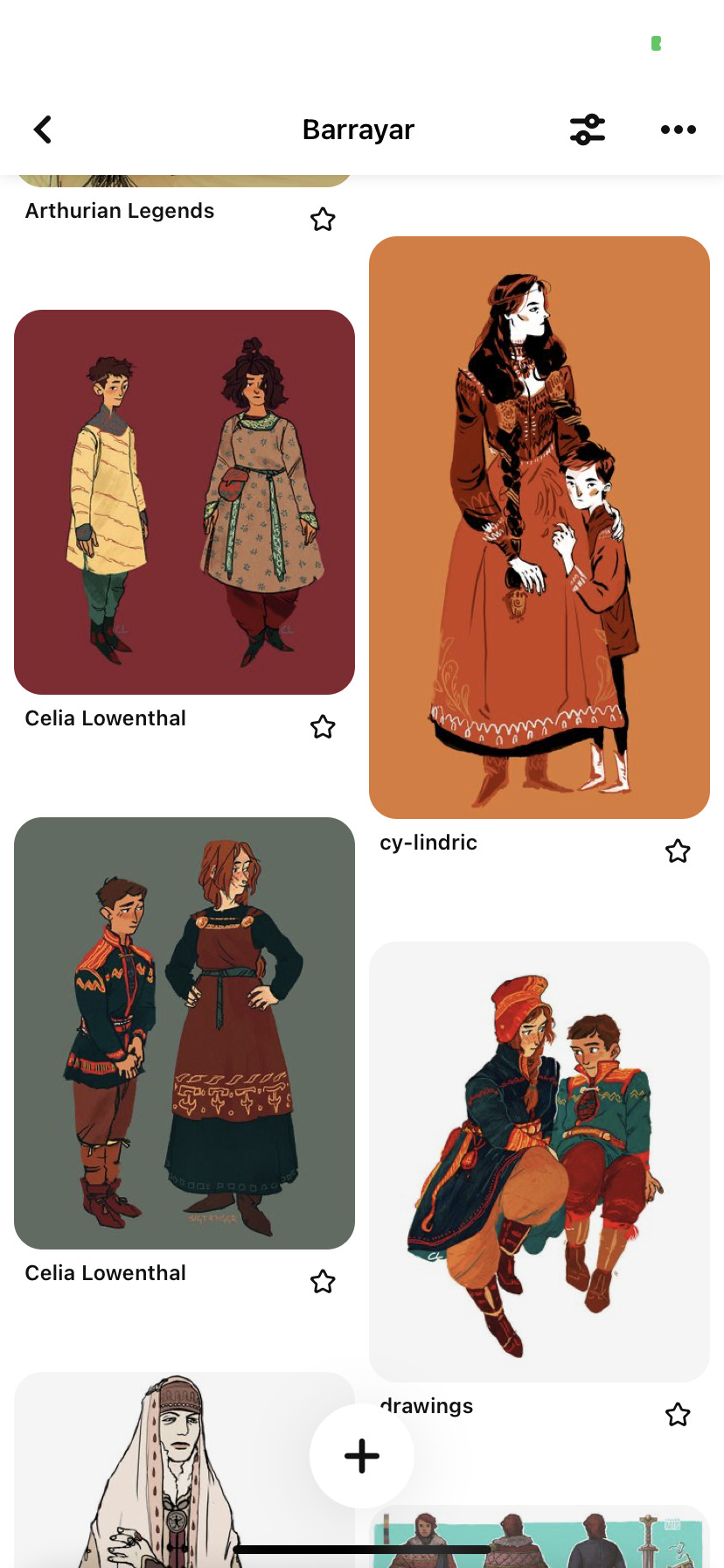
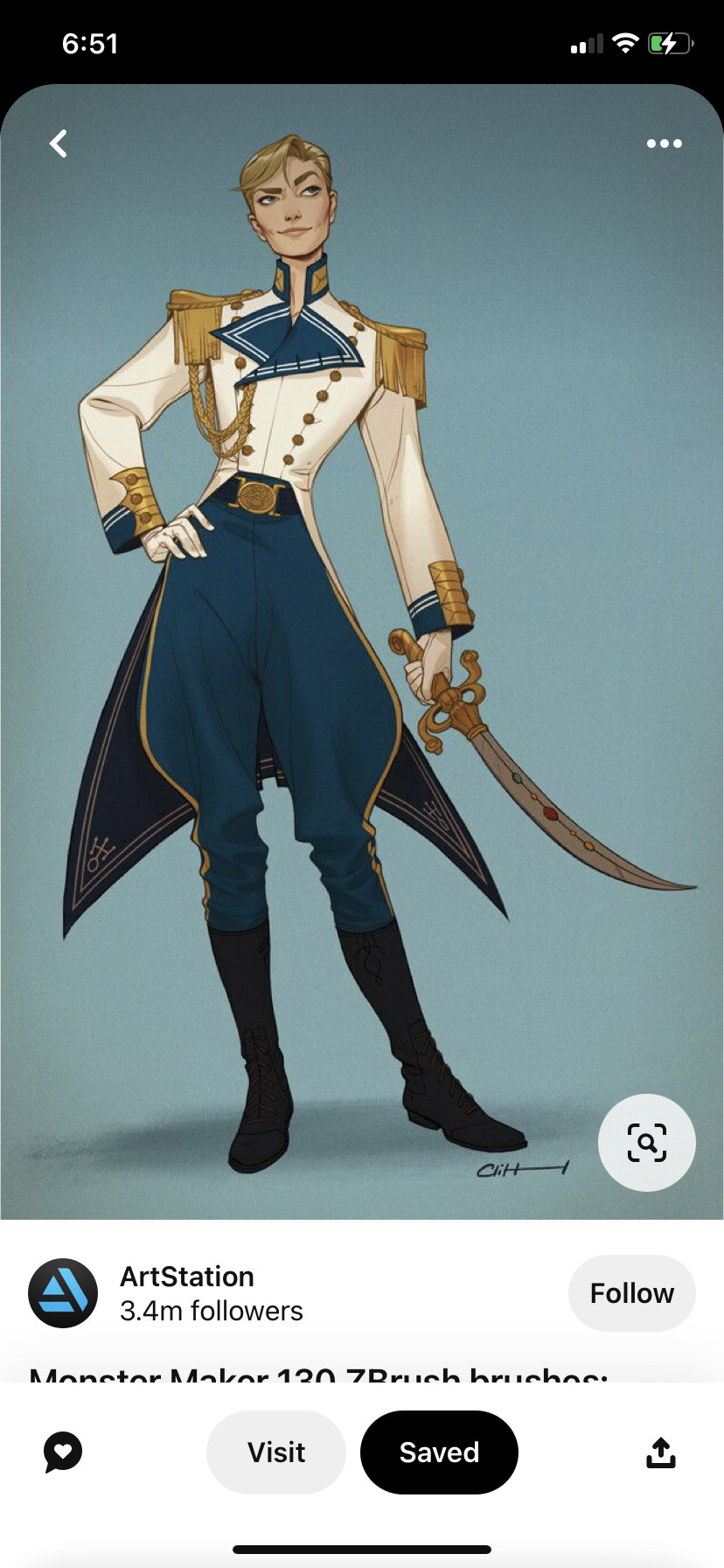

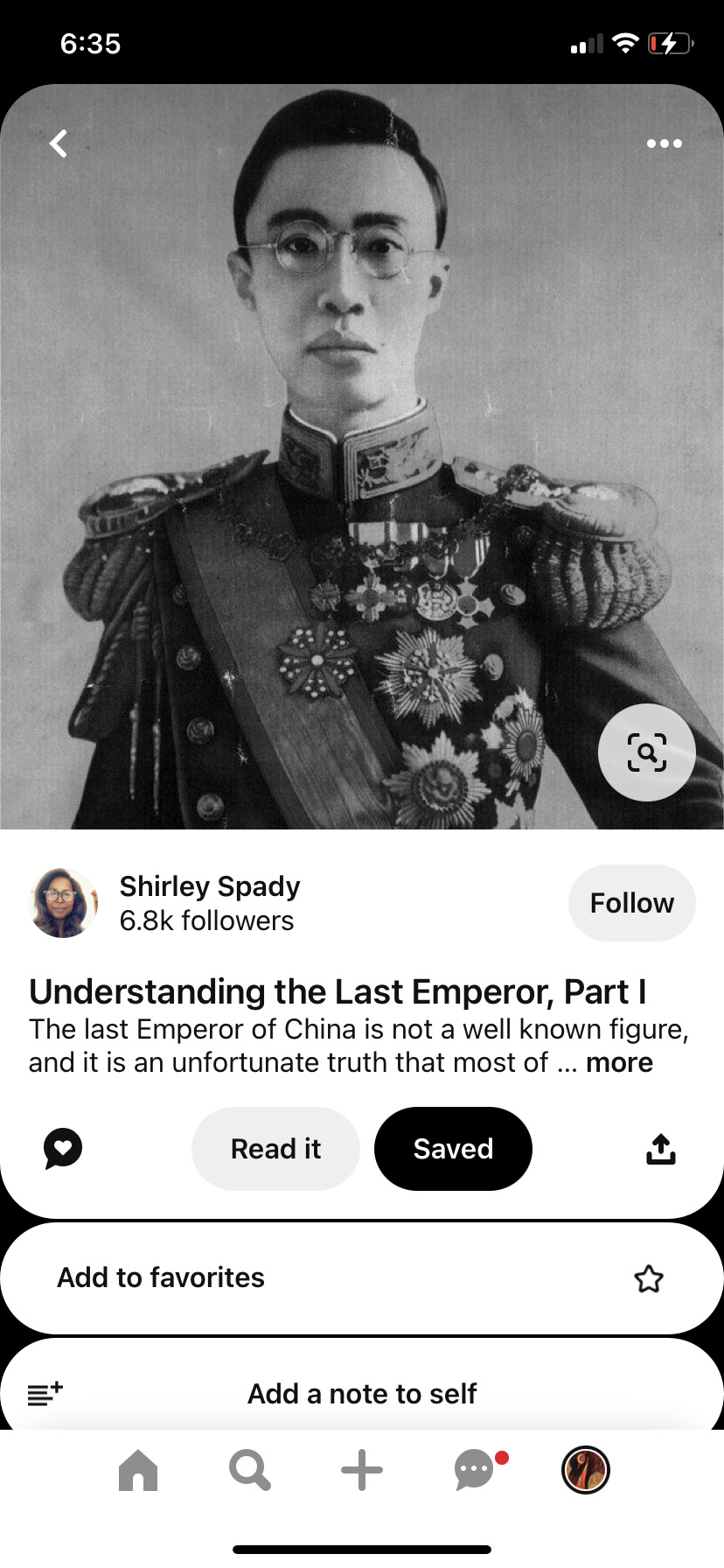

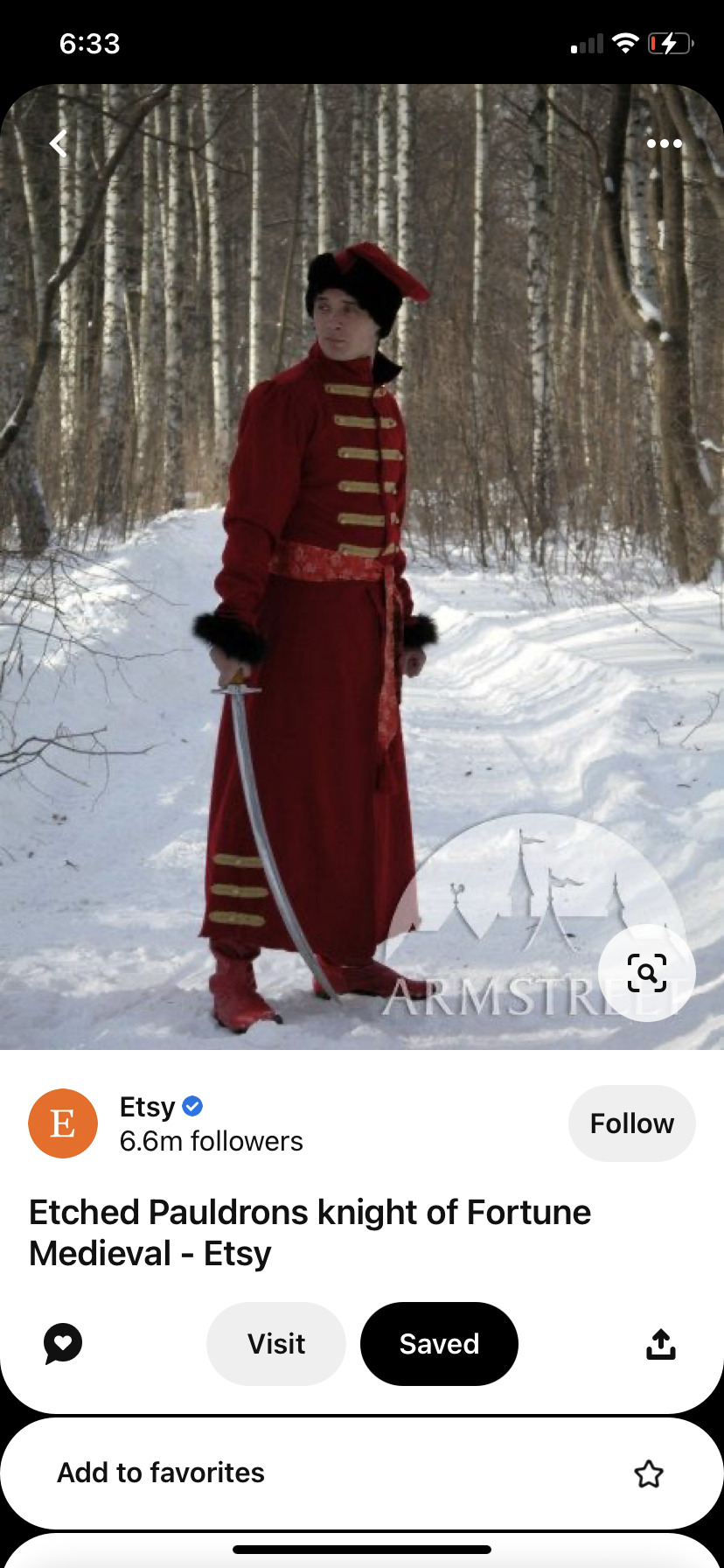
And many many sooooo many more. So much borrowed creativity from all over the internet I feel bad I can’t more accurately site all my sources 😞
Also some random cool aesthetic modern shit that I thought had fun sci fi vibes as well as some *sigh* generic-euro fantasy clothing cuz sometimes you need to be a little basic.
Also a lot of cool art by artists I love that is just dope costume design and totally all their work. Idk the names of a lot of them cuz I’m not really active on social media and only really see the images amidst thousands of others in my Pinterest hoard but I always recognize the artsyles and creativity and wind up saving them to reference art boards 🙈
Some that I do remember and love a lot are cy-lindric, Juliette, and Celia Lowenthall
#barrayar#barrayaran clothing#lois mcmaster bujold#fanart#vorkosigan#vorkosigan fanart#scifiart#costume design#character design#concept art#vorkosigan saga#barrayaran fashion#barreyaran clothes
182 notes
·
View notes
Text
Reenactments and Accuracy
I saw someone in a video talking about why she didn't use silk for an 18th-century ball gown reproduction and the complaints she got about historical accuracy and the expense.
I think EVERYONE misses out on one aspect of this. A ball gown was an upper-class garment that you needed upper-class money to wear.
Jenny who sews the dress couldn't afford the fabric for it. For the purposes of analogy, 'most anyone who does historical reenactments is about at the income level of Jenny who sews the dress. Seamstress was a midlevel skilled trade analogous to today's general office worker. (People who worked for the upper class directly were often considered lucky for the income or relative status and somewhat less abuse.)
14 notes
·
View notes
Note
I’m wondering if you have any examples of Irish clothing from the early 1600s (around 1610-1615)? I haven’t been able to find much from this era so I’d appreciate any sources or museum collections that you could recommend.
Starting this out with the caveat that if you're looking for the same level of detail and precision that we have for English dress history in this period, you are going to be disappointed. The types of English primary sources we have for this period (well-dated detailed paintings, well-preserved rich-people clothing, wills, printed books, etc) just don't exist for Ireland. There also seems to be much less research interest in 16th-17th c. Irish dress history, so there isn't nearly as much for secondary sources (books, articles etc.).
You don't mention if you are interested in a specific region in Ireland. Ireland in the early 17th c. was a pretty heterogeneous place. People in Dublin and Waterford wore English-influenced styles. According to British-appointed solicitor-general Sir John Davies, by 1606 a few of the wealthier people in Connacht had started wearing English dress, but many others were still wearing Irish clothing. Ulster was a mix of Irish who were wearing Irish dress and incoming English and lowland Scots settlers.
All of the extant Irish clothing I know of from the early 17th c. comes from either bogs or archaeological excavations. It looks like you've already seen my post on extant garments at the NMI. The NMI also has a couple of felt hats that might be early 17th c. This one is from Knockfola, Co. Donegal. It originally had a decorative cord or band where the pale line is:

There are also another cóta mór and brat, found on a bog body from Leigh, Co. Tipperary, which I don't think the NMI has on display. I did not bother to include them in my post, because they are so similar to the ones from Killery, Co. Sligo, but the fact that these have been found in multiple places suggests that they were common, widely-used garments.
The other major garment-find from this period is the Dungiven outfit which is in the Ulster Museum. a short video The bright blue thread was added by a modern conservator; it's not original. (Side note: The identification of this outfit has gotten unfortunately politicized. Tartan trews were worn by both the Irish and the Scots during the 17th century (McClintock 1943, Dunlevy 1989). The presence of tartan should not be used to draw conclusions about the ethnicity of the wearer.) The primary publication for this outfit:
Henshall, Audrey, Seaby, Wilfred A., Lucas, A. T., Smith, A. G., and Connor, A. (1961). The Dungiven Costume. Ulster Journal of Archaeology, 24/25, 119-142. https://www.jstor.org/stable/20627382
The one other reasonably-well preserved outfit that has published on is from a child burial from Emlagh, Co. Kerry, now at University College Cork. Shee and O'Kelly give it a late 17th c date, but they largely base this date on the presence of a rather generic-looking comb. IMO the outfit could easily be early 17th c.
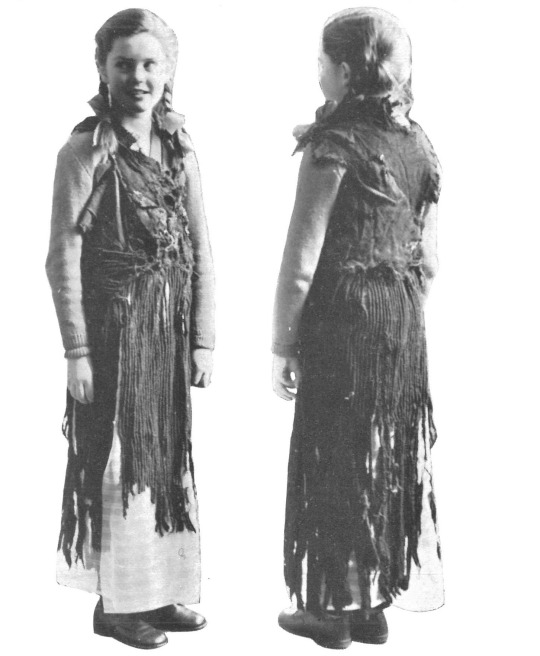
The Emlagh gown, photographed on a living 8-year-old child who was wearing a sweater and skirt underneath. (The 1960s was a different time.)
The bodice has a wrap-front closure with a back and button-up sleeves similar in cut to the Killery cóta mór. The skirt is a pleated rectangle with the pleats sewn in vertically, somewhat like the Shinrone gown. Publication:
Shee, E. and O'Kelly, M. (1966). A Clothed Burial from Emlagh, near Dingle. Journal of the Cork Historical and Archaeological Society, 71(213), 81-91.
There are also, frustratingly, a bunch of fragmentary clothing finds at the NMI which might be 17th c, but no one seems to care enough to do publications on them, and NMI Archaeology still does not have their collection on-line, so they are useless to us.
The typical Irish shoe for this period is known as a brogue (also called a Lucas type 5 by archaeologists). broguesandshoes.com has photos, a pattern, and construction information.
Unfortunately, the illustrations from Speed's map are the only images I know of from this specific period.
If you want details on what materials were used, I recommend Susan Flavin's dissertation. It's about the 16th c. economy, but things didn't change that much between 1599 and 1601. free download here
If you don't mind wading through early modern English and a bit of period-typical prejudice, I recommend reading A Discourse of Ireland, by Luke Gernon written in 1620. His description of Irish clothing starts halfway down p. 356.
Finally, if you can find them, Dress in Ireland by Mairead Dunlevy (1st ed. 1989) and Old Irish and Highland Dress by H. F. McClintock (1st ed. 1943, 2nd ed. 1950) are the best books I know of for this period.
20 notes
·
View notes
Text
Continuation of this
Pietro clutches at her skirts, but reels back obediently when she smacks his desperate hands.
“Please, my sweet,” he begs, trailing after her, resisting the urge to grab her again. “Please talk to me. Tell me what you’re thinking.”
Kelsi doesn’t deign to look at him, simply storms through the estate — a historic castle that had been rather beautiful before her death — hunting down any scrap of her old life.
Her satchel and carpetbag are still in the downstairs closet, exactly where she left them. Even the contents is untouched, a few crumpled receipts and an expired granola bar buried inside.
She grabs both, and the big, red rain coat. Pietro always used to hide candies in the pockets; she stops herself for checking for one.
When she emerges from the closet, he’s directly behind her, so close she can see the tears budding in his eyes, not yet fallen. She doesn’t soothe him—she won’t.
The kitchen is dilapidated. She can’t find anything edible, only food so spoiled it can hardly be considered food at all, and a staggering amount of coffee grounds. Maybe he’d been surviving on caffeine alone, these past years.
“Please,” he tries again. “Kelsi, please?”
“You know my thoughts, Doctor.” She pushes past him, up the stairs to the second floor. The boards creak miserably under her weight, untreated, in poor condition. “I am very, very, very upset with you.”
Despite the derelict condition of the rest of the castle, her room could almost be considered clean. There’s a fine layer of dust on most of the surfaces, but it’s clear that the bedding has been washed somewhat recently, the curtains beaten to get rid of the worst of the residue buildup.
Her wardrobes contents is different, although not how she would expect. New clothes, garments shes never seen before, are hung amidst the rest. They’re soft to the touch, don’t show the signs of deterioration and rigidity that come with neglect.
Pietro had regularly washed each each of them by hand, ironing them carefully before returning them to their rightful place. He wasn’t sure why. During the first few months, he thought she should be comfortable, when she returns. Soon enough he hardly thought at all. It was more of a ritual, a lower-brain habit, to tend to her things, to hunt for any remnants of her scent among the items, to imagine her, vital and alive in these spaces.
She understands this, somehow, without a word. Another exhibit of the madness that consumed him in her absence. Grimacing, she starts shoving fistfuls of fabric into her bag, indiscriminately.
At the bottom, tucked away in the corner, is a pair of boots. Pretty, but functional, fine, embroidered details and treated leather.
The night before she died, she’d complained about her feet aching. They’d surveyed the entire surrounding woods, an arduous endeavor that left her exhausted, sore. He’d gifted her a warm balm, of his own recipe. Awkward as he placed it into her hands; he’d wanted to rub it into her tender muscles himself, she could see the desire in him. But it was a line neither of them had ever broached, a delicate, tremulous thing.
He’d pulled her out of deadly mires. She’d plucked poison barbs from his skin. They’d both risked their lives and reputations for each other, again and again. They knew one another better than anyone. At times it seemed like they could read each other down to the flickering soul.
And yet, there was another distance impossible to broach. Not due to lack of courage, but careful sensibility. It required investigation, a steady hand. Whatever it was between them, it often felt as fragile as spiders silk.
Now it was snapped, forever.
Kelsi shoves into the boots, swallowing down her distaste. It was this, or go barefoot on her journey. She snaps her bags closed. She’s ready to be gone.
Pietro stands in doorway, preventing this.
His head is bowed, fearful of her gaze, but even hunched his height is imposing. She always thought of his as a sproutish man, lean and lanky, but facing him now she’s not sure she could beat him, physically.
“Can you please—“ he bites his lip. “Can’t you be very, very, very upset with me here? Where you’re safe? Where I can see you?”
Kelsi just breathes for a moment. She’s so incensed her rage has surpassed physical revile; she’s only focused on undoing what’s been done, now. “No,” she tells him.
She takes a step forward. And another. They’re toe to toe, and she can almost feel his heart beating, a rabbit-quick pulse. His cheeks flush.
He presses himself into the doorframe, letting her pass. Yielding.
He falls in stride behind her. “Dearest, please. Things are not as you remember them.”
“I know,” she snaps. “You did that.”
His fingers brush her sleeve, cautious but beseeching. “Where are you going?”
“To get them out. I will extract them. Somehow.”
It takes a moment for her to realize Pietro is no longer right behind her. He’s paused in the center of the lobby, staring at her. His expression is hard to decipher, agony and confusion and something without a name.
“You can’t,” he says. She can barely hear it.
“I’m certain I’ll find a way. If there’s any trace of them left in me, I will pluck it out.”
“You can’t,” he says again, louder. “You’ll die.”
She shakes her head. “I already did.”
The great door was never her first choice for access. It’s twice her size, and so heavy she has to throw her entire weight against the wood to budge it. Pietro is saying something to her, but she can’t make it out, too focused on escaping his madness to try.
Finally, the door rocks open.
On the other side is a giant, bloodwasp.
The creatures, roughly the size of a toddler and infinitely more dangerous, had all but vanished from the estate and its surroundings after Pietro’s carnivorous plants took root. Kelsi hadn’t seen one for years after she moved in.
She’s certainly not prepared to deal with one, now.
In her shock she doesn’t hear the click of the bullet in the chamber, but the sound of it firing her knocks her to the ground.
The wasp falls too, dead, a perfect shot through the eye.
Pietro rushes to the door, shutting it quickly. Beyond him, Kelsi spots the thrumming bodies of at least three more wasps. Who knows what their numbers are, how many lurk outside.
Pietro sinks to his knees at her side, bundling her up with an arm around her shoulders, a look of ardent concern on his face. In his other hand, the revolver is still steaming.
“I meant to tell you that the roads are no longer safe,” he says, “but you wouldn’t listen. Now, let’s talk about this like civilized adults.”
But he makes no move to release her. Simply holds her there, against his chest, reveling in skin that’s warm again.
Weakly, Kelsi asks, “Dr. Pragma, where did a scholar learn to shoot like that?”
#a study in devotion#adoring mad scientist x darling he brought back to life who wants nothing to do with him#spoiler but um….#tw insects#tw wasps#pathetic wet dog of a man pretty handy with a gun actually#he is actually very strong under the tweed#Kelsi will ALWAYS win their fights though because he could never even think of harming her#I love them they’re SO fucked up and insane
38 notes
·
View notes
Text





The Blue and Red Caftan of Jean-Francois Portaels
Or as I like to call it, griping about uncritical (and at times, maliciously misattributed) use of historical images in costume research, especially from Orientalists. I recently came across images 2 and 5 being reposted as Egyptian historical fashion. While the women in these two paintings wear necklaces similar to Egyptian ones, the style of necklace itself was popular across a VERY broad region (I believe I've even seen Balkan necklaces of a similar style). In painting 2 Portaels does not specify where the woman depicted is from, though the title of 5 indicates the depiction intends to be of a woman from Cairo.
In the first image, I can tell you the woman is Moroccan (her earring and under caftan are pretty distinct), though he does not specify this. Woman 2 is wearing what looks to be a yelek, which would indicate she's Egyptian, if we assume she's North African. Woman 5 is probably also wearing a yelek, but the cut looks oddly loose. The difference between the yelek and the caftans more common to the Maghreb is that a yelek is of a tighter cut, and has a low, oval neckline that potentially can reveal cleavage, which is found on a few other contemporary Egyptian garments. In practice, the yelek itself was often hidden under another garment, and usually had an underdress covering the chest, despite depictions otherwise. The exception would be dancers and certain other professions.
Further, the decoration and shape of the garment do not resemble Egyptian garments. A tob sebleh, to my understanding, would have a longer sleeve. The embroidery and cordwork are somewhat unusual and look more Maghrebi, though it's harder for me to judge this definitively as it's hard to find enough detailed photos of Egyptian cordwork to form a general impression. Additionally, I feel like I've seen a Tunisian men's garment that looks almost exactly like this, but in white with gold cord.
Frankly, given this caftan shows up so often, I think it was a real garment Portaels had, and I don't think he cared about where it was from when choosing to paint it. He was an Orientalist painter, and while some of that school painted with great accuracy and humanity, their work always needs to be carefully judged. My guess is that the garment is of Maghrebi origin. It is the sartorial centerpiece of most of these paintings, wfich is why though details of 2 and 5 are accurate enough, I find myself mildly annoyed that these are being shared without context.
#cipher talk#actually egyptian tag#Masr#Egyptian fashion#Egyptian culture#Plus the people sharing these straight up lie and fabricate information sometimes#Like literally pretending Algerian clothing is Egyptian or claiming henna designs based on Nepalese art are Egyptian#Very annoying people
16 notes
·
View notes
Note
Hi! I have a question about... sleeves.
I am looking at designing what is essentially, in-universe, a stage costume but still want it to be at least a tiny bit historically accurate.
It would be a late Jiaqing era (~1810s) inspired aoqun, with a mamianqun (specifically a fengweiqun) and possssssibly a cloud collar to form an ensemble that's intended to portray a fenghuang (thus the skirt lol) and probably somewhat fancy on account of the celestial nature.
I know that sleeves in China have historically often been either long or Extremely Long especially for noblewomen but I was wondering about how that extends (ha) to the Jiaqing era of the Qing Dynasty.
I see, for example, Ming-style clothing that has these very long, drapey sleeves such as these: https://ziseviolet.tumblr.com/post/702949049252364289/ (though I know the Ming would have ended like 200 years before the 1810s but I also know you've mentioned that a lot of Ming fashion continued into the Qing for a while) I like the way they look on account of being very flowy which seems fitting for a bird-themed outfit where the person wearing it would be essentially portraying the fenghuang onstage, so long flowing gauzy shapes seem very fitting, but I'm not sure how much flexibility there is for late Qing sleeve styles or how much creative license goes into those types of XYZ dynasty-inspired outfits.
Relatedly I'm curious how common sheer, soft-draped fabric like that would have been in the early 1800s. I know it was very popular in certain eras, and of course in western fashion at the time Regency clothing used a lot of soft loose shapes, so I'd be interested to know if that kind of thing was particularly common in the 1810s in China or not.
I think sleeves started getting much shorter and more tight fitting in the 18th century, but wide sleeves saw something of a revival by the turn of the 19th. In the Jiaqing era, sleeves could be described as wide but not necessarily long, and usually had folded cuffs that reduced the length. I haven't read about actual garments from that period so I can't tell you concretely, but that appears to be the case from artworks.
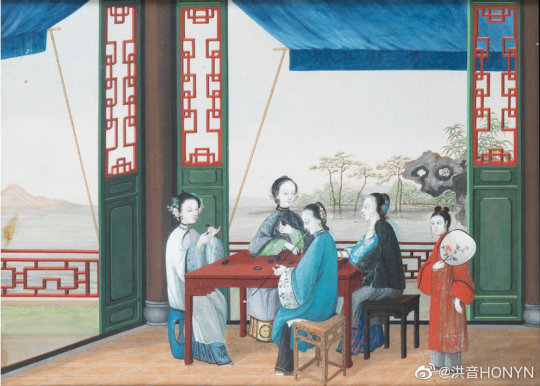
The blogger 盥薇 did a recreation of Jiaqing era dress based on export paintings, in her interpretation the sleeves are also still a little too long to be entirely practical but definitely not as long and drape-y as that in earlier centuries. This outfit might work as a reference for your costume, since it also features a cloud collar? (on a side note, the comment section of this video gives me psychic damage, please don't look)
About sheer, soft fabrics, yes they were indeed very popular around this time, and had been since the late Ming. Sheer clothes were usually meant for lounging around the house in warm weather and not worn outside, and sometimes you see women represented as forgoing underwear altogether. I'm not sure whether that's an artistic embellishment, but it does feel feasible given the domestic setting.
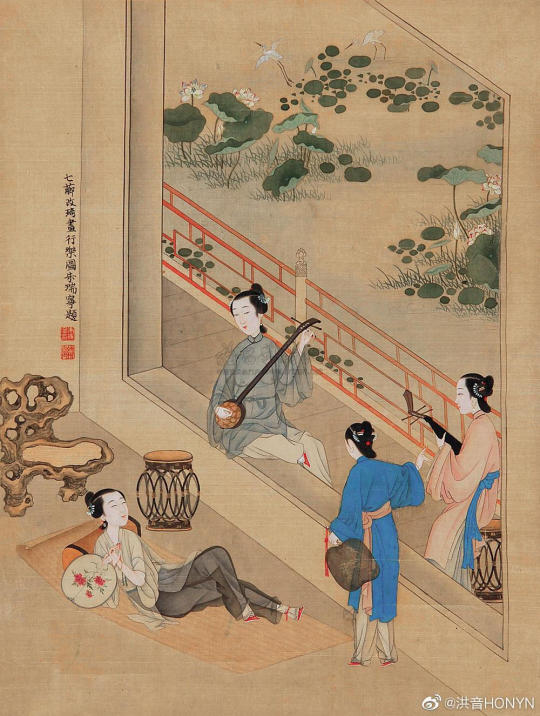
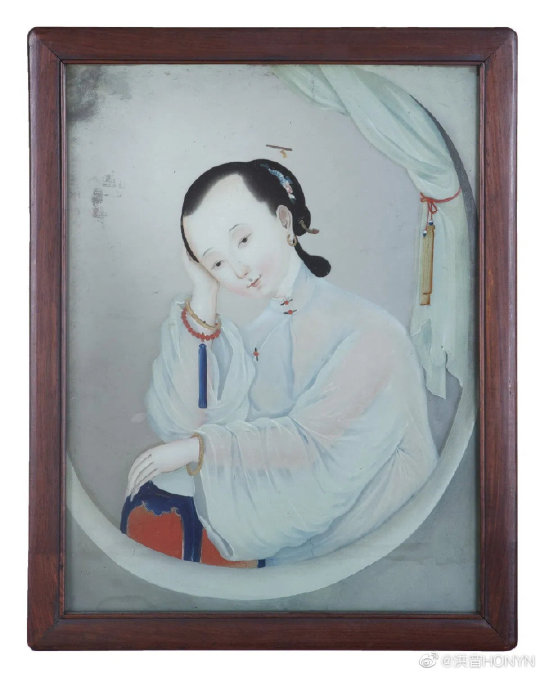
I explained in this post that the cliche of 'late Ming fashion continuing into the Qing' only actually applies to the 1650s. So the Jiaqing era, being in the early 19th century, has nothing to do with the Ming.
66 notes
·
View notes
Text
Welp Rachel Aaron told me to send pictures if I make an Eli Monpress cosplay, so now I guess I have to find a pattern to alter so I can do that.
So here's a little post about how I find my patterns.
First, finding any, and I mean ANY type of pattern for a masculine cut/shape/fit pattern of any kind, is going to be difficult. Menswear has never had the variety or market that yields many unique patterns like women's fashion does. So finding specific garments can be really hard, and if you're working in the realm of costume and cosplay, impossible. I started out cosplaying masculine characters back in 2018, lot of suits I tell you, and while I'll point out some men's patterns here, spoiler alert: its so much more fun to alter women's patterns to get the level of serve, that fictional characters tend to provide. It's a sad fact, men's patterns suck, they suck so much ass.
Modern Patterns, this includes modern costumes: Simplicity, Butterick, McCALLs, Vogue. All of these are available at Joanns. And hear me when I say this, don't buy it if its 20 dollars, all of those brands go on sale seasonally, and tops you should be paying for those is 3 bucks. With the exception of Vogue, they go on sale for like 5.99, but you shouldn't be buying from Vogue anyway.
Butterick: I haven't made many of this company's patterns, they don't have a lot of costumes that service my needs, and their clothes tend to be too modern for my tastes-BUT I used their pattern for a priest's cassock and that was very easy to follow and I still wear that garment.
McCALLs: Tried and true, great costumes, I use their patterns as bases for my costumes a lot. Easy to use and just have very interesting garments.
Simplicity: Some gems, some shit, and you won't know till you try. I do have good patterns from them but other's that don't actually fit together. Only thing going for them is price, so again get them on sale, and make a mock up to test the pattern. But if you find a pattern that works, you'll be able to do a lot with it, they have a lot of versatility in their designs.
Vogue: Do not buy Vogue. Vogue patterns are known in the sewing community to be fuckers to sew. Needlessly hard, sewing Vogue patterns is like being handed written directions on how to make ice cream in an ice cream mixer, but then the picture directions are how rewire a car, and half the language used is in french and a third of the pictures are missing. And for what? a garment that has fake pockets. Vogue doesn't like you sewing their patterns let alone alter them, and I've been sewing costumes since 2017 and its the only pattern that made me run crying to my mother. Don't make my mistakes, do not buy that pattern.
Now all of these companies are sold in Joanns, with the looming threat of that company closing possibly in the next year or so, all of these pattern brands are also online, you just gotta look.
Etsy: Great place to buy costume patterns, somewhat alright for getting old discontinued patterns from the brands above.
Etsy Patterns will come one of three ways, resold (you'd get an original branded packet in the mail), PDF Print out (great if you have access to a printer), or fabric pattern pieces shipped to you that you then lay out on your fabric just as any pattern.
The most common will be print out, but you can find anything from vintage to costume to antique to modern, and you can look at reviews and see what people have made with the patterns.
Most of the costumes I made in 2024 were from Etsy shops: HistoricalAtelier, BlackSnailPatterns, and RabbitAndHatPatterns.
(Note, when buying historical patterns, be very careful to check the measurements, a lot of Etsy sellers, and historical pattern sellers in general, don't offer size ranges in their singular patterns. And sizing up or down can be a hard sewing skill to learn.)
Altering Patterns: Once you find a pattern you like, it can be easy to change it to fit your costume. Changing a sleeve shape can mean drafting a new pattern piece or simply swapping out one sleeve piece for a second pattern's piece. And once you get that process down, the world's your playground, changing bodice shapes, lapels, closures, pleat this, dart that. Have a grand old time.
It's through this process I make most of my cosplays, but it is specifically helpful for making masc characters. Because as I said, it's hard to find options when men's fashion has barely changed through history, but anyway
The most important step when making costumes in this way, is you want to dress from the skin-out.
What does this mean?
When you are altering a garment to fit you, you need to have your body in the exact shape you want it to be when you wear the finished product, you need your proper foundation, or what you build on top won't look correct. SO if you're say, sewing a jacket, and you know underneath you will have a dress shirt and vest, you can't be wearing a tee shirt or something, or you'll risk the clothes not fitting later.
This also includes if you are choosing to wear shape wear that alters your body in anyway: sports bra, binder, tape, undershirts (this ofc goes the other way, if you're padding your chest, you gotta keep track of fit and measurements so your finished clothes fit).
In my Miranda cosplay, I made it knowing okay, shirt, vest, jacket, and even with the waistband of my pants, I made sure to wear each layer as I sewed the next so that everything would lay neatly and perfectly when I had the complete outfit on. I knew with that cosplay I wasn't going to wear my sports bra cus the vest is sturdy enough and the extra layer would be hot, so that meant it had to go when I tried on my alterings.
Drafting: Drafting is making your own patterns, most of the time from templates, measurements, and a fuck ton of math. It can be very hard, it gets harder the more complicated your design gets. But you can find hundreds of videos on how to draft patterns for hats, props, capes, belts, skirts, and full costumes on Youtube, with step by step instructions.
And, if I'm being completely honest with myself, I will probably be drafting the patterns for this Eli cosplay, as all my previously highlighted methods of pattern sourcing have lead me to dead ends.
Anyway here have some ideas I found an hour into my three hour search


My first thought had been mayhaps I match Eli to Miranda and go with a 1890s silhouette, but I forgot how disproportionate the level of serving was between genders. Like the beautiful gown with meaning and inspiration, a work of art really, and then oh yay a tailcoat penguin looking headass(I do want to make a tailcoat but like that's not at all Eli's cover art jacket).


And then these were the wrong era to match with Miranda anyway, but they were pretty fun. Maybe one day I'll remake the left one from 1826 in Sparrow colors, like magenta or turquoise. cus dayum thats a dandy yk
(EDITOR FANDOMMIND HERE, LOOK AT THIS FANCY GENTLEMAN I FOUND

I take it back, if I make a Sparrow cosplay I want what these two are on. this was the first thing that came up when I googled Dandy just to fact check something, and this is from 1831 so I wasn't far off.

And then just because it's so much easier to find cool fem patterns and ideas, I have wanted that sweater for years, one day I'll make it and we'll get to add another dash to the Miranda cosplay tally. And oh look another bicycle suit
#legand of eli monpress#the legend of eli monpress#eli monpress#miranda cosplay#miranda lyonette cosplay#eli monpress cosplay#cosplay plans#tips and tricks#nothing like an email from the author herself to get my butt in gear with this cosplay
3 notes
·
View notes
Text
Story Ideas (TW: long post incoming but there's poll at the end and every participant gets a sticker)
As was decided by about 100 people: here are some ideas I had for IFs (all in different degrees of "worked-out" and at the end, you can vote on which ones you find the most interesting.
1
The first one basically makes the MC a teacher at a prestigious high school (although they might make you do classes at the also very prestigious elementary school) and it involves planning lessons and dealing with usual teenage shenanigans. The ROs would be other teachers, the odd parent maybe, and perhaps someone from maintenance? Who knows... It's meant to be a cute slice-of-life thing because I eat that shit up.
2
For this one, I pretty much only wrote down "It was a beautiful day at court and you are a horrible jester". ROs would be Prince/Princess, maybe a foreign visitor with Oberyn Martell vibe.
3
The MC is part of a big mafia family but is mostly trying to live a somewhat normal life. Now, you are acquainted with the family business but you don't play an active part in it. But if someone was to mess with you, well, your family would do anything for you. This one is inspired by the song "Bust Your Kneecaps" by Pomplamoose.
Now to my three favorites:
4
Are you familiar with the novel "Krabat"? We've read it in school and I thought it was really cool, even though it is a little dark, to be honest. It's based on a cluster of Sorbian legends and follows the story of Krabat, a poor orphan boy becoming an apprentice at a mill, where the miller is also practicing and teaching black magic to his twelve apprentices and every year one boy dies in mysterious circumstances. The title I'd give this would probably be "Rapaki", which is Sorbian for ravens, which play a role in the story as well. It could prove to be a challenge to make this historical setting as inclusive as I want it to be (and also since there's a specific character I'd love to have as a RO, but he's an adult and the apprentices are pretty much all teenagers).
5
You were kidnapped by aliens. Now, it's been a couple of months since you arrived at the space station. They don't really seem to want to do anything with you except study humans and you happen to be one of the subjects. You are given spacious living quarters, activities for enrichment, food (they sometimes test things by giving you weird stuff and see if you eat it or not) and even many opportunities for socialization with the other human subjects. Honestly, it's not bad. Beats scrambling for money to pay rent. The newest addition to the human sample group though seems to be very discontent with their new abode. Are you helping them to escape, are you just tagging along for the ride, or are determined to stay in your cozy lab?
6
You are perfect nobility. Your family is hosting a ball to which all the most important members of the ton are invited. There's good food and drink, entertainment and music. You socialize and dance. You even go for a secret midnight swim in the deep fountain in the gardens. Many days are like this and you enjoy it. But one day something very peculiar happens: The ball is in full swing when you notice a person in very strange clothes just striding through the dance hall, never acknowledging the guest or the music but looking at a strange... device in their hands. When they aim to go upstairs towards your private living spaces you decide to follow them but they simply disappear. Were they a ghost? Are you hallucinating? For several days you see more strange figures, some of them in strange clothing, some of them in garments from the past. They never seem as ... corporal as the first one and at this point you fear you have lost your mind. Then the first intruder comes back and you can confront them. They seem awfully aghast when you politely ask them to leave.
Turns out, you are a ghost, reliving the last day of your life, and they are a ghost hunter from the future. The whole manor as you know it seems to crumble, polished floors become broken wood, the furniture disappears and the big chandelier lies demolished on the ground. You learn that the other figures are ghosts, like yourself, former inhabitants of the manor before and after you. And you meet them. They are as flabbergasted by this revelation as you were. The ghost hunter explains that they've been chasing a haunting spirit for some time now and they actually weren't intending to call forward you or the others. Do you all help them catch the evil ghost?
Inspired a little by the bbc chow "Ghosts".
#story ideas#another thing I thought of that would be better as a novel or movie probably is something about Fredericka “Marm” Mandelbaum#You should definitely read the wikipedia article about her#that's girlpower if you ask me
36 notes
·
View notes